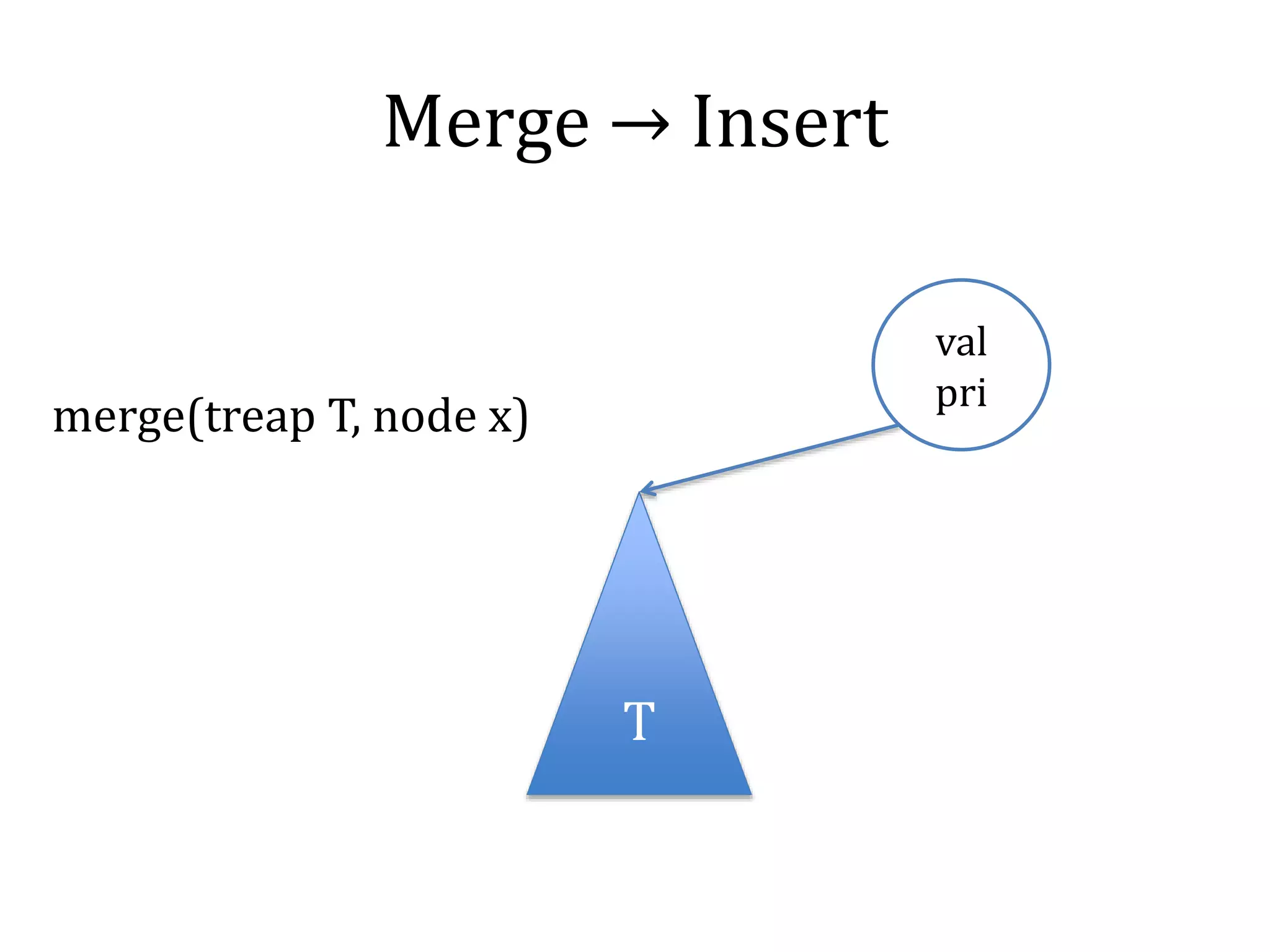The document discusses binary index trees (also called Fenwick trees) and segment trees, which are data structures that allow efficient querying of array prefixes and intervals. Binary index trees support adding values to array elements and retrieving prefix sums in O(log n) time. Segment trees similarly support adding values and finding maximum/minimum values in intervals in O(log n) time. Both achieve faster query times than naive solutions by representing the array as a tree structure.

![Binary Index Tree
Problem:
Give an array A[1], A[2] , … , A[n] and m
queries as follows (n, m ~ 10^6)
type 1: add x to A[k] (1 <= k <= n)
type 2: calculate sum of interval [l , r] of array](https://image.slidesharecdn.com/datastructure-tree-141114225212-conversion-gate02/75/Datastructure-tree-2-2048.jpg)
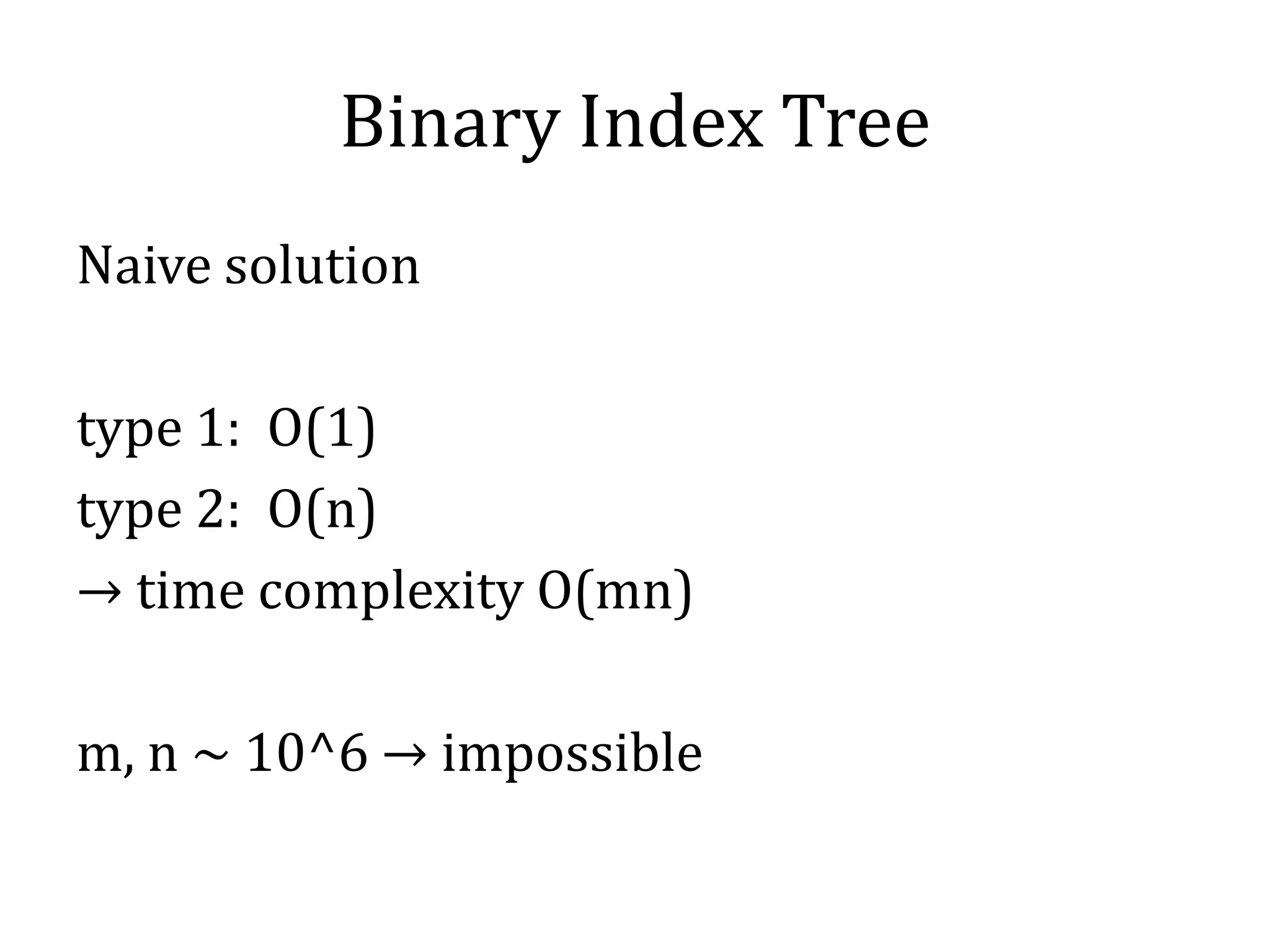
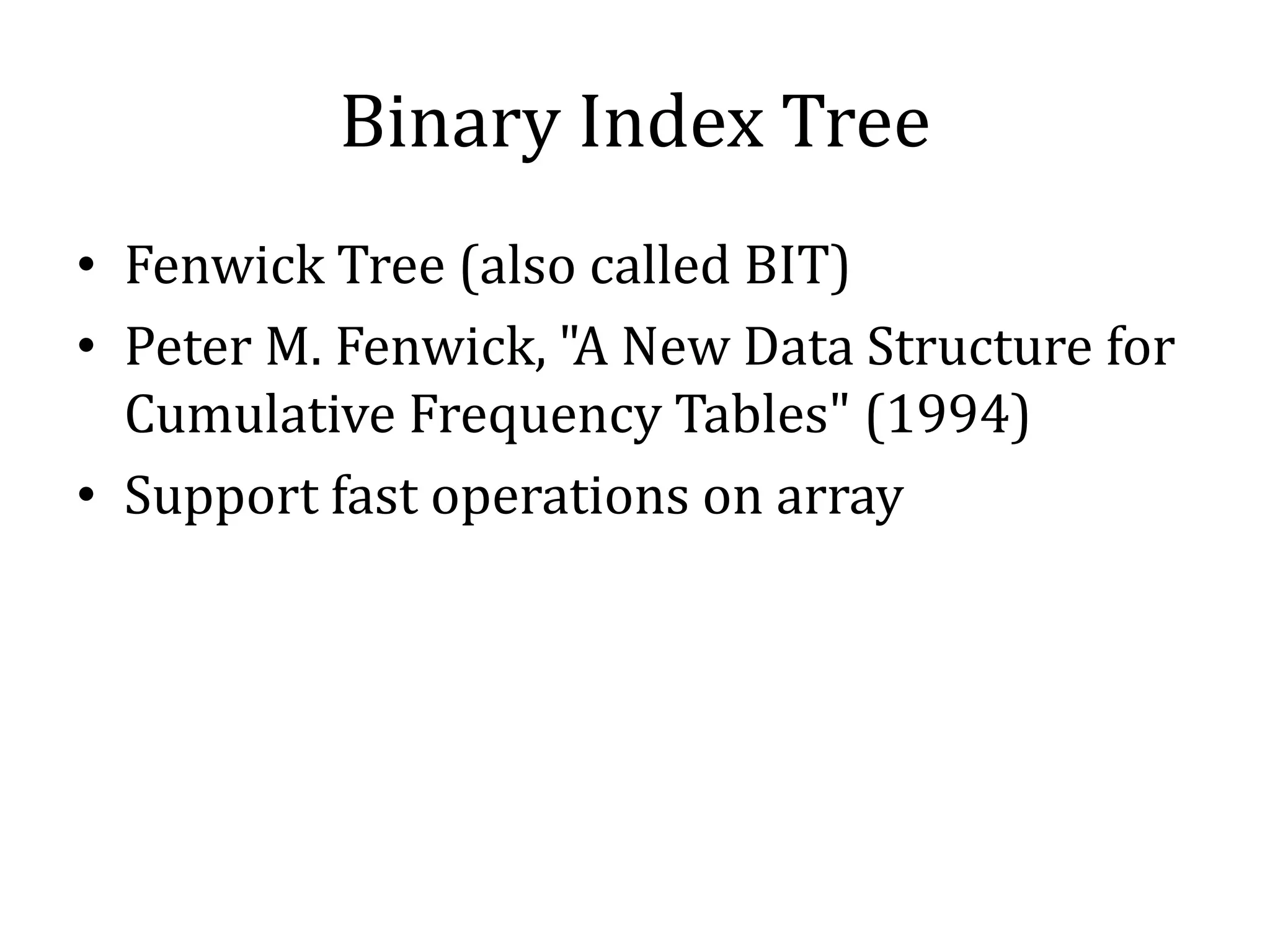
![Binary Index Tree
Support two operations in O(log(n))
[1] Add value x to an element A[k]
A[k] → A[k] + x
[2] Return sum of prefix k
prefix[k] = A[1] + A[2] + ... + A[k]](https://image.slidesharecdn.com/datastructure-tree-141114225212-conversion-gate02/75/Datastructure-tree-5-2048.jpg)
![Binary Index Tree
A[1] + A[2] + A[3] + A[4] A[5] + A[6] + A[7] + A[8]
A[1] + A[2] + A[3] + A[4] + A[5] + A[6] + A[7] + A[8]
A[1] + A[2] A[3] + A[4] A[5] + A[6] A[7] + A[8]
A[1] A[2] A[3] A[4] A[5] A[6] A[7] A[8]](https://image.slidesharecdn.com/datastructure-tree-141114225212-conversion-gate02/75/Datastructure-tree-6-2048.jpg)
![Binary Index Tree
A[1] + A[2] + A[3] + A[4] A[5] + A[6] + A[7] + A[8]
A[1] + A[2] + A[3] + A[4] + A[5] + A[6] + A[7] + A[8]
A[1] + A[2] A[3] + A[4] A[5] + A[6] A[7] + A[8]
A[1] A[2] A[3] A[4] A[5] A[6] A[7] A[8]
add to A[1]](https://image.slidesharecdn.com/datastructure-tree-141114225212-conversion-gate02/75/Datastructure-tree-7-2048.jpg)
![Binary Index Tree
A[1] + A[2] + A[3] + A[4] A[5] + A[6] + A[7] + A[8]
A[1] + A[2] + A[3] + A[4] + A[5] + A[6] + A[7] + A[8]
A[1] + A[2] A[3] + A[4] A[5] + A[6] A[7] + A[8]
A[1] A[2] A[3] A[4] A[5] A[6] A[7] A[8]
add to A[3]](https://image.slidesharecdn.com/datastructure-tree-141114225212-conversion-gate02/75/Datastructure-tree-8-2048.jpg)
![Binary Index Tree
A[1] + A[2] + A[3] + A[4] A[5] + A[6] + A[7] + A[8]
A[1] + A[2] + A[3] + A[4] + A[5] + A[6] + A[7] + A[8]
A[1] + A[2] A[3] + A[4] A[5] + A[6] A[7] + A[8]
A[1] A[2] A[3] A[4] A[5] A[6] A[7] A[8]
get prefix[3]](https://image.slidesharecdn.com/datastructure-tree-141114225212-conversion-gate02/75/Datastructure-tree-9-2048.jpg)
![Binary Index Tree
A[1] + A[2] + A[3] + A[4] A[5] + A[6] + A[7] + A[8]
A[1] + A[2] + A[3] + A[4] + A[5] + A[6] + A[7] + A[8]
A[1] + A[2] A[3] + A[4] A[5] + A[6] A[7] + A[8]
A[1] A[2] A[3] A[4] A[5] A[6] A[7] A[8]
get prefix[7]](https://image.slidesharecdn.com/datastructure-tree-141114225212-conversion-gate02/75/Datastructure-tree-10-2048.jpg)
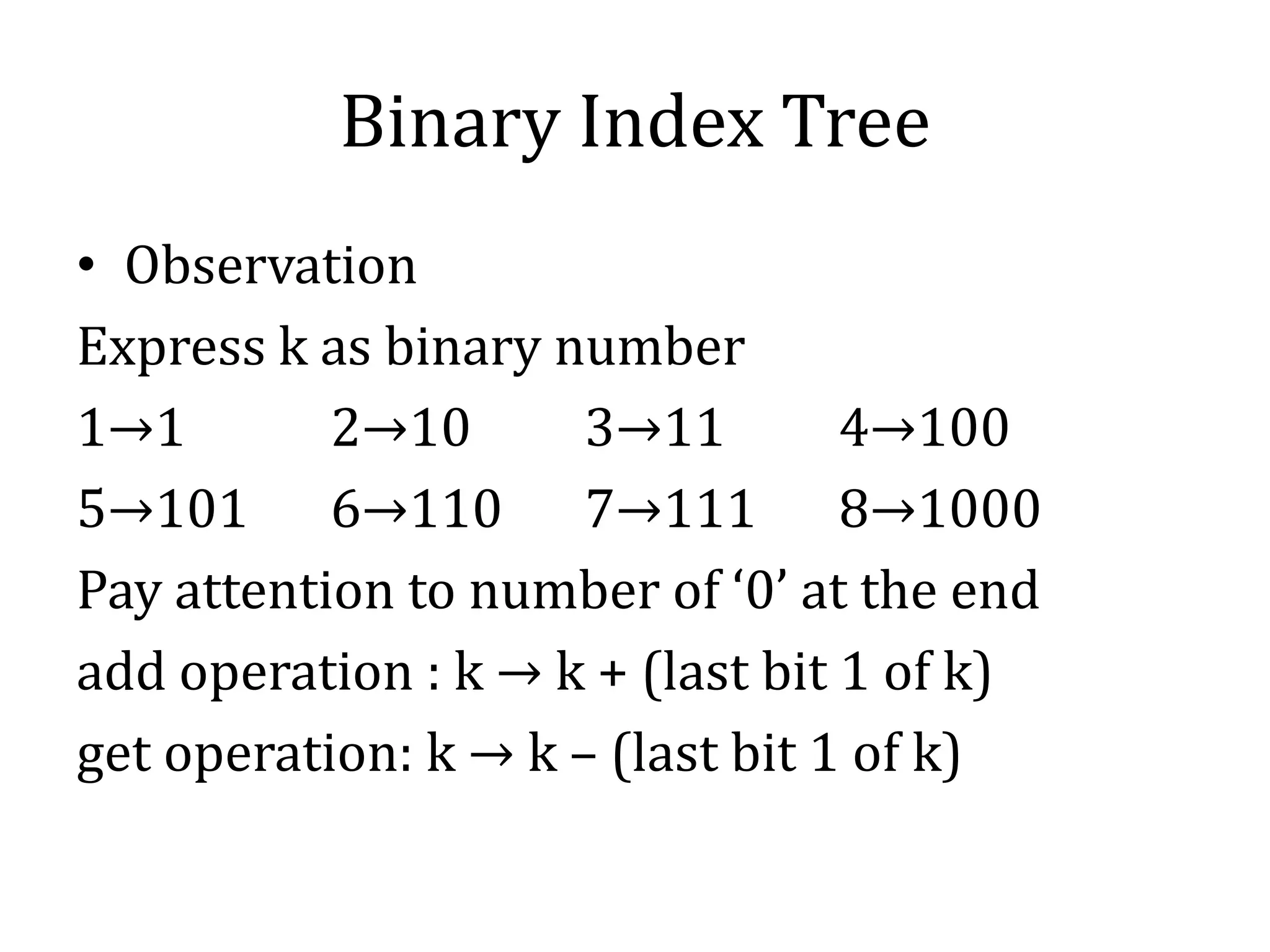
![Binary Index Tree
[1] Add value to element at position index
void add(int index, int value) {
for (int i = index; i <= size; i += i & -i) {
bit[index] += value;
}
} → O(log(n))](https://image.slidesharecdn.com/datastructure-tree-141114225212-conversion-gate02/75/Datastructure-tree-12-2048.jpg)
![Binary Index Tree
[1] Get sum of elements from postion 1 -> index
int get(int index) {
int ans = 0;
for (int i = index; i > 0; i -= i & -i) {
ans += bit[i];
}
return ans;
} → O(log(n))](https://image.slidesharecdn.com/datastructure-tree-141114225212-conversion-gate02/75/Datastructure-tree-13-2048.jpg)
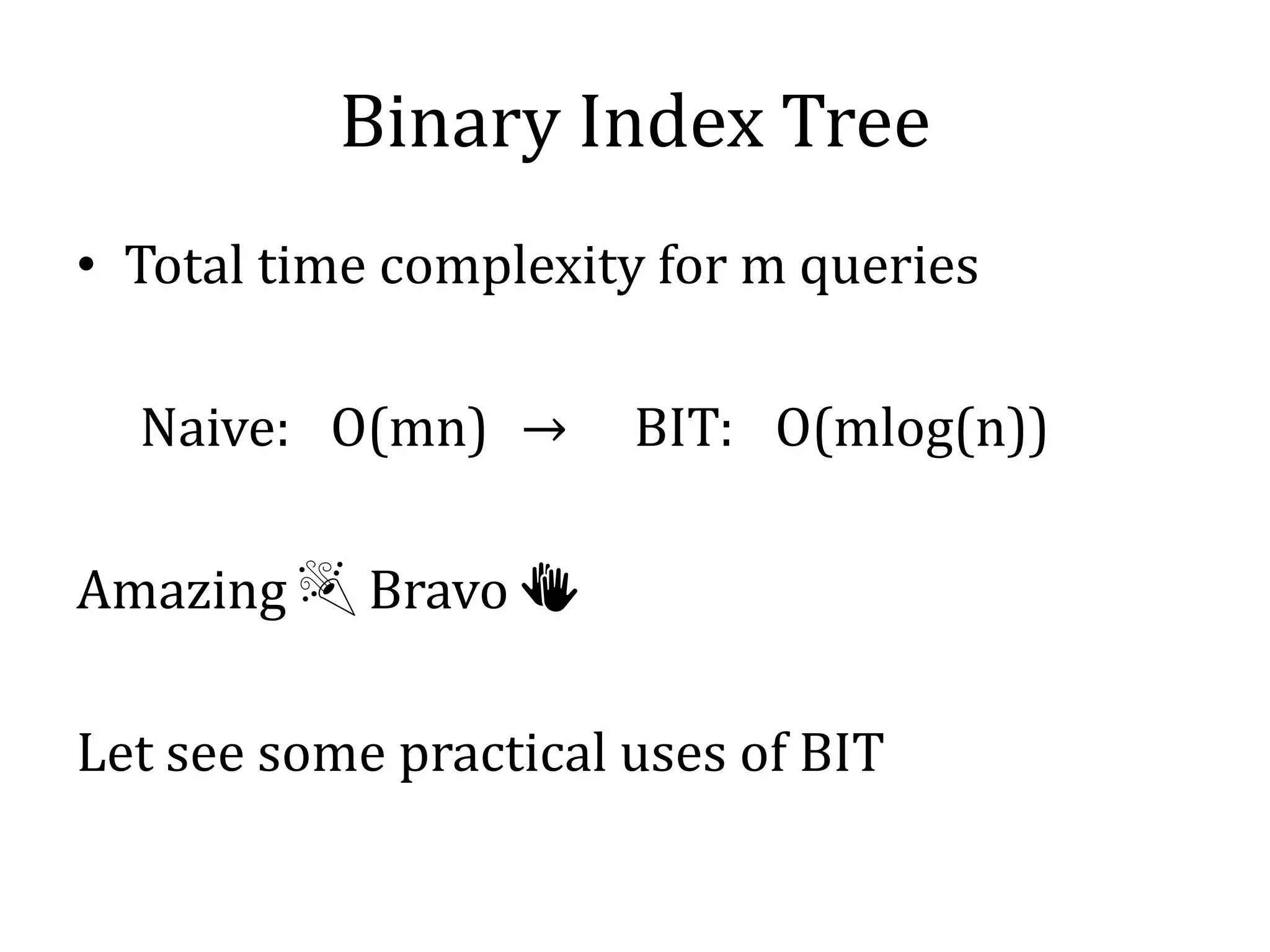
![Count Inverse Pair
Give an array A[1], A[2], ..., A[n], n ~ 10^6
Count number of pair (A[i], A[j]) such that
i < j and A[i] > A[j]
Naive solution: scan all pairs (A[i], A[j]) , i < j
→ time complexity O(n^2) → impossible](https://image.slidesharecdn.com/datastructure-tree-141114225212-conversion-gate02/75/Datastructure-tree-15-2048.jpg)
![Another solution
• Using technique of merge sort
Divide and conquer (A[1], ... ,A[n])
→ (A[1], ... ,A[n/2]) ∨ (A[n/2+1], ..., A[n])
solve(A[1], ... ,A[n/2])
solve(A[n/2+1], ..., A[n])
merge(A[1], ... ,A[n/2] ∨A[n/2+1], ..., A[n])
Time complexity O(nlog(n))](https://image.slidesharecdn.com/datastructure-tree-141114225212-conversion-gate02/75/Datastructure-tree-16-2048.jpg)
![Using BIT
Suppose 1 <= A[1], A[2], ..., A[n] <= n and are
integer.
If not, we can make a mapping by sort because
we only consider about magnitude correlation
ex: (1.2, -9.8, 5.0, 3.4) → (2, 1, 4, 3)](https://image.slidesharecdn.com/datastructure-tree-141114225212-conversion-gate02/75/Datastructure-tree-17-2048.jpg)
![Using BIT
int ans = 0;
void solve() {
for (int i = 1; i <= n; ++i) {
ans += i - 1 - get(a[i]);
add(a[i], 1);
}
}](https://image.slidesharecdn.com/datastructure-tree-141114225212-conversion-gate02/75/Datastructure-tree-18-2048.jpg)
![D-Query
Problem:
Given an array n number A[1], A[2], ..., A[n]
and m queries as follows (n ~ 3x10^4, m ~
2x10^5, 1 <= A[i] <= 10^6)
query : (l, r) return number of distinct
elements in subarray A[l], A[l+1], ..., A[r]
→ Cann’t solve with naive solution](https://image.slidesharecdn.com/datastructure-tree-141114225212-conversion-gate02/75/Datastructure-tree-19-2048.jpg)
![D-Query
Solution with BIT
[1] Sort queries based on right value
(l1,r1), (l2,r2), ..., (lm, rm)
→ r1 <= r2 <= ... <= rm
[2] Go through array from left to right, using
index[] to save last position each value
→ index[x] is last position of x in current array](https://image.slidesharecdn.com/datastructure-tree-141114225212-conversion-gate02/75/Datastructure-tree-20-2048.jpg)
![D-Query
Solution with BIT
[3] Current value a[i]
*if index[a[i]] != i then update index[a[i]] = i
*if there is some r[j] = i then calculate
answer and go to next queries
*else go to next postion
[4] Print answers](https://image.slidesharecdn.com/datastructure-tree-141114225212-conversion-gate02/75/Datastructure-tree-21-2048.jpg)
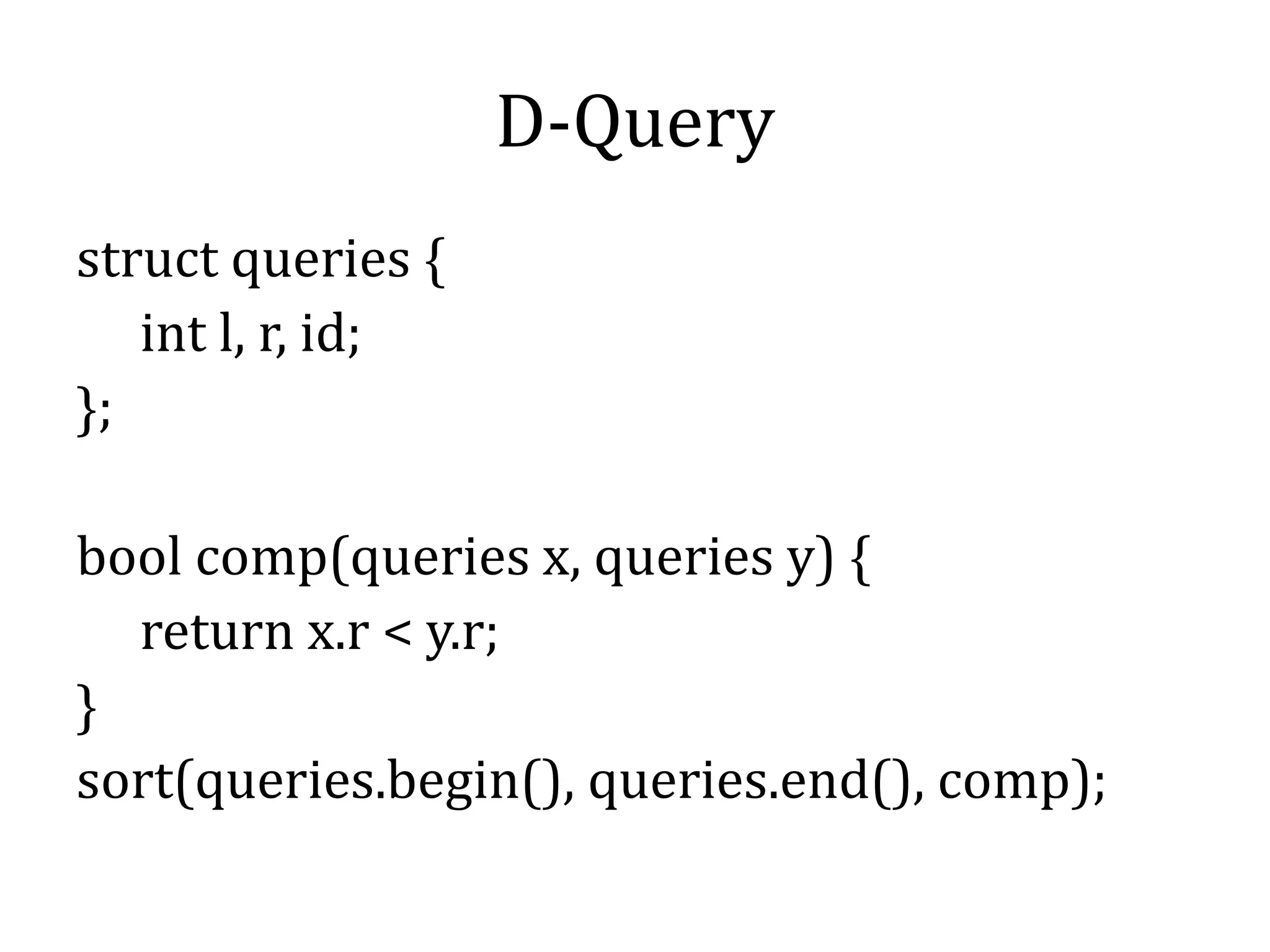
![D-Query
for (int j = 0, i = 1; j < num_queries;) {
if (index[a[i]] != i) {
bit.add(index[a[i]], -1);
index[a[i]] = i;
bit.add(i, 1);
}
if (queries[j].r == i) {
ans[queries[j].id] += bit.get(i) – bit.get(queries[j].l – 1);
j++;
}
else i++;
}](https://image.slidesharecdn.com/datastructure-tree-141114225212-conversion-gate02/75/Datastructure-tree-23-2048.jpg)
![D-Query
1 1 2 1 3
3 queries
[1, 5]
[2, 4]
[3, 5]
index[1] = -1
index[2] = -1
index[3] = -1
3 queries
[2, 4]
[1, 5]
[3, 5]](https://image.slidesharecdn.com/datastructure-tree-141114225212-conversion-gate02/75/Datastructure-tree-24-2048.jpg)
![D-Query
1 1 2 1 3
3 queries
[1, 5]
[2, 4]
[3, 5]
3 queries
[2, 4]
[1, 5]
[3, 5]
index[1] = 1
→ bit.add(-1, -1) , bit.add(1, 1)
index[2] = -1
index[3] = -1](https://image.slidesharecdn.com/datastructure-tree-141114225212-conversion-gate02/75/Datastructure-tree-25-2048.jpg)
![D-Query
1 1 2 1 3
3 queries
[1, 5]
[2, 4]
[3, 5]
3 queries
[2, 4]
[1, 5]
[3, 5]
index[1] = 2
→ bit.add(1, -1) , bit.add(2, 1)
index[2] = -1
index[3] = -1](https://image.slidesharecdn.com/datastructure-tree-141114225212-conversion-gate02/75/Datastructure-tree-26-2048.jpg)
![D-Query
1 1 2 1 3
3 queries
[1, 5]
[2, 4]
[3, 5]
3 queries
[2, 4]
[1, 5]
[3, 5]
index[1] = 2
index[2] = 3
→ bit.add(-1, -1) , bit.add(3, 1)
index[3] = -1](https://image.slidesharecdn.com/datastructure-tree-141114225212-conversion-gate02/75/Datastructure-tree-27-2048.jpg)
![D-Query
1 1 2 1 3
3 queries
[1, 5]
[2, 4]
[3, 5]
3 queries
[2, 4]
[1, 5]
[3, 5]
index[1] = 4
→ bit.add(2, -1) , bit.add(4, 1)
→ ans[2] = bit.get(4) – bit.get(1)
index[2] = 3
index[3] = -1](https://image.slidesharecdn.com/datastructure-tree-141114225212-conversion-gate02/75/Datastructure-tree-28-2048.jpg)
![D-Query
1 1 2 1 3
3 queries
[1, 5]
[2, 4]
[3, 5]
3 queries
[2, 4]
[1, 5]
[3, 5]
index[1] = 4
index[2] = 3
index[3] = 5
→ bit.add(-1, -1) , bit.add(5, 1)
→ ans[1] = bit.get(5) – bit.get(0)](https://image.slidesharecdn.com/datastructure-tree-141114225212-conversion-gate02/75/Datastructure-tree-29-2048.jpg)
![D-Query
1 1 2 1 3
3 queries
[1, 5]
[2, 4]
[3, 5]
3 queries
[2, 4]
[1, 5]
[3, 5]
index[1] = 4
index[2] = 3
index[3] = 5
→ ans[3] = bit.get(5) – bit.get(2)](https://image.slidesharecdn.com/datastructure-tree-141114225212-conversion-gate02/75/Datastructure-tree-30-2048.jpg)
![Segment Tree
Problem:
Give an array A[1], A[2], ..., A[n] and m queries
as follows (n, m ~ 10^6)
type 1: add x to A[k]
type 2: calculate max, min on interval [l, r]](https://image.slidesharecdn.com/datastructure-tree-141114225212-conversion-gate02/75/Datastructure-tree-31-2048.jpg)
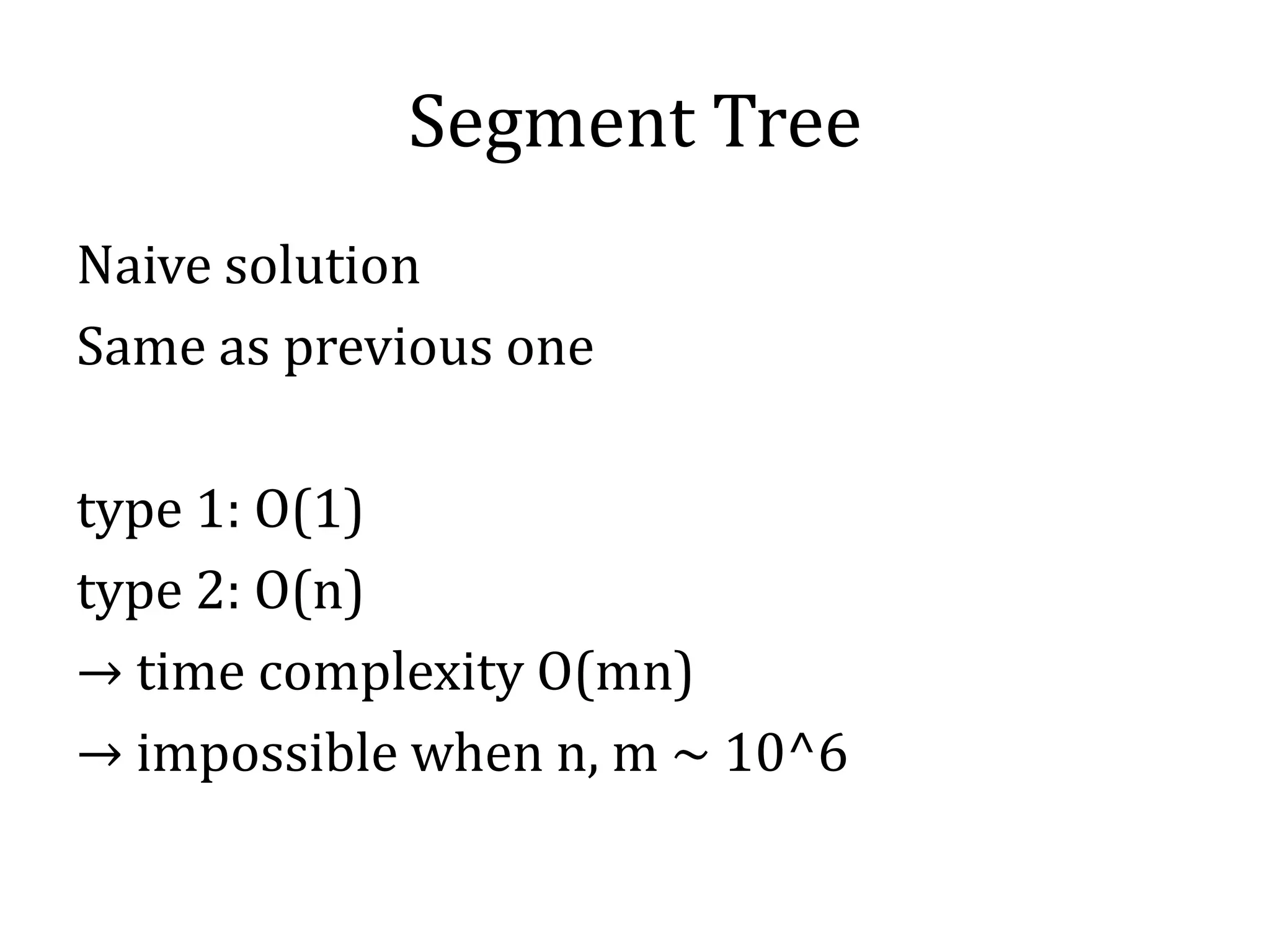
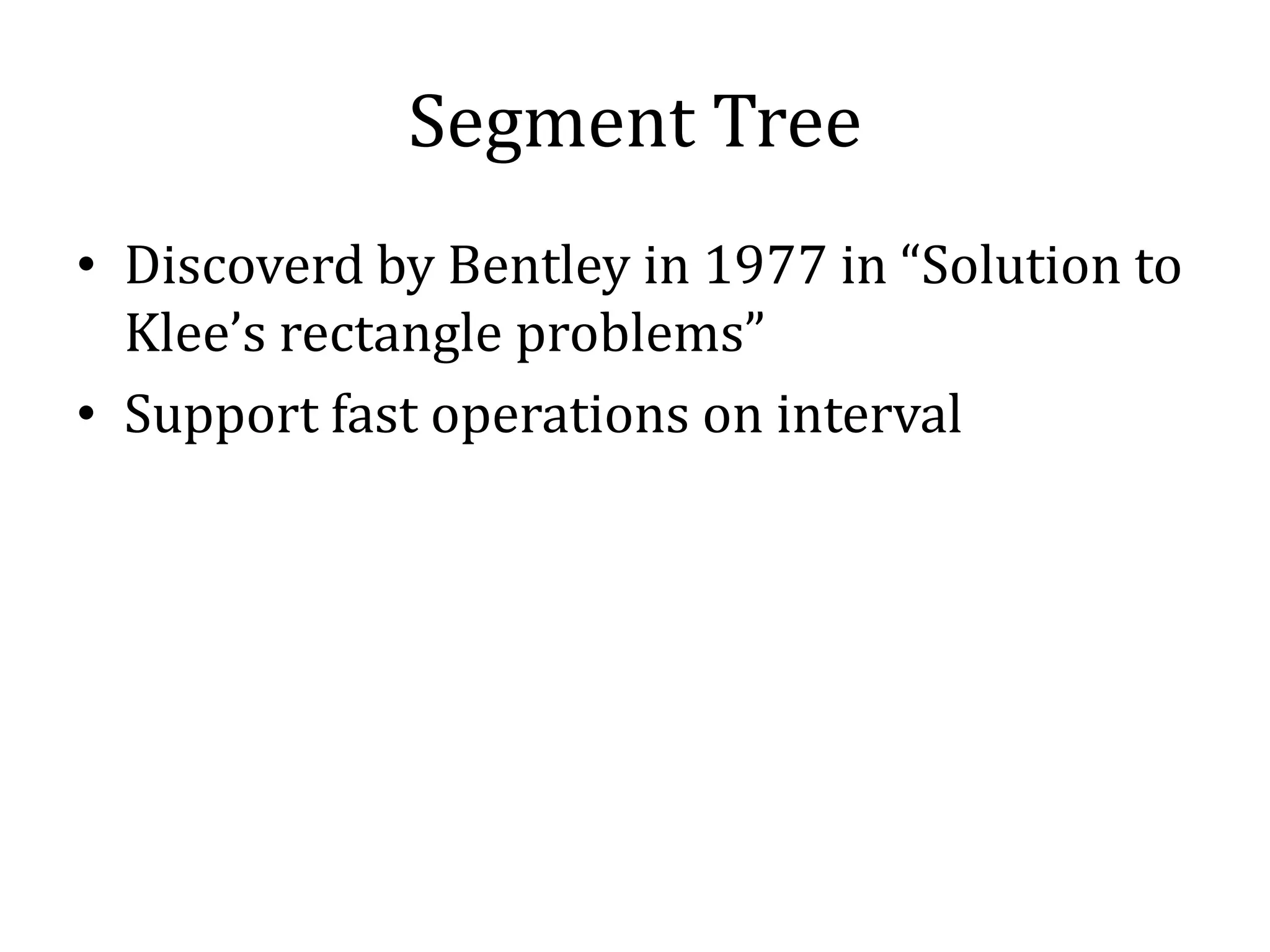
![Segment Tree
A[1] + A[2] + A[3] + A[4] A[5] + A[6] + A[7] + A[8]
A[1] + A[2] + A[3] + A[4] + A[5] + A[6] + A[7] + A[8]
A[1] + A[2] A[3] + A[4] A[5] + A[6] A[7] + A[8]
A[1] A[2] A[3] A[4] A[5] A[6] A[7] A[8]](https://image.slidesharecdn.com/datastructure-tree-141114225212-conversion-gate02/75/Datastructure-tree-34-2048.jpg)
![Segment Tree
A[1] + A[2] + A[3] + A[4] A[5] + A[6] + A[7] + A[8]
A[1] + A[2] + A[3] + A[4] + A[5] + A[6] + A[7] + A[8]
A[1] + A[2] A[3] + A[4] A[5] + A[6] A[7] + A[8]
A[1] A[2] A[3] A[4] A[5] A[6] A[7] A[8]
add to A[2]](https://image.slidesharecdn.com/datastructure-tree-141114225212-conversion-gate02/75/Datastructure-tree-35-2048.jpg)
![Segment Tree
A[1] + A[2] + A[3] + A[4] A[5] + A[6] + A[7] + A[8]
A[1] + A[2] + A[3] + A[4] + A[5] + A[6] + A[7] + A[8]
A[1] + A[2] A[3] + A[4] A[5] + A[6] A[7] + A[8]
A[1] A[2] A[3] A[4] A[5] A[6] A[7] A[8]
add to A[6]](https://image.slidesharecdn.com/datastructure-tree-141114225212-conversion-gate02/75/Datastructure-tree-36-2048.jpg)
![Segment Tree
A[1] + A[2] + A[3] + A[4] A[5] + A[6] + A[7] + A[8]
A[1] + A[2] + A[3] + A[4] + A[5] + A[6] + A[7] + A[8]
A[1] + A[2] A[3] + A[4] A[5] + A[6] A[7] + A[8]
A[1] A[2] A[3] A[4] A[5] A[6] A[7] A[8]
get max on [3,8]](https://image.slidesharecdn.com/datastructure-tree-141114225212-conversion-gate02/75/Datastructure-tree-37-2048.jpg)
![Segment Tree
• Each node of tree is an interval [l, r]
• If l < r, it has two children [l, m] and [m+1, r]
with m = (l + r)/2
• Length of array is n → total node of tree is
1 + 2 + 4 + ... + 2^k = 2^(k+1) – 1
k is smallest number such that 2^k >= n
→ total node <= 4n, memory O(n)](https://image.slidesharecdn.com/datastructure-tree-141114225212-conversion-gate02/75/Datastructure-tree-38-2048.jpg)
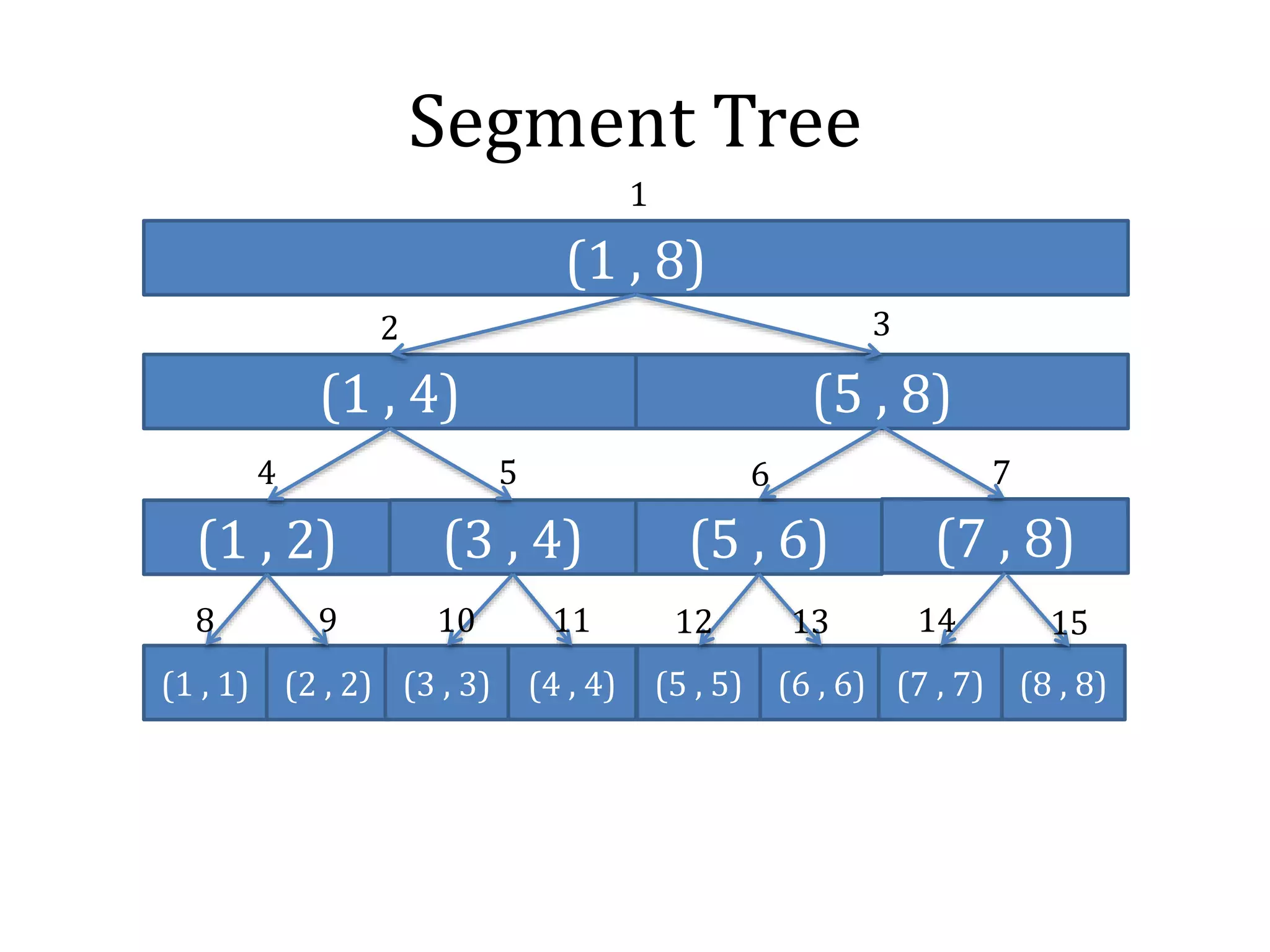
![Segment Tree
*Initialize: build(1, 1, n)
void build(int node, int l, int r) {
if (l == r) {sg[node] = A[l]; return;}
int m = (l + r)/2;
build(node * 2, l, m);
build(node * 2 + 1, m + 1, r);
sg[node] = max(sg[node * 2], sg[node * 2 + 1]);
} → O(n)](https://image.slidesharecdn.com/datastructure-tree-141114225212-conversion-gate02/75/Datastructure-tree-40-2048.jpg)
![Segment Tree
*Add x to A[k]: update(1, 1, n, k, x)
void update(int node, int l, int r, int k, int x) {
if (l == r) {sg[node] = A[k] + x; return;}
int m = (l + r)/2;
if (m >= k) update(node * 2, l, m, k, x);
else update(node * 2 + 1, m + 1, r, k, x);
sg[node] = max(sg[node * 2], sg[node * 2 + 1]);
} → O(log(n))](https://image.slidesharecdn.com/datastructure-tree-141114225212-conversion-gate02/75/Datastructure-tree-41-2048.jpg)
![Segment Tree
*Get max on interval [l,r]: query(1, 1, n, l, r)
int query(int node, int i, int j, int l, int r) {
if (l<=i && j <= r) {return sg[node];}
int m = (i + j)/2;
if (m >= r) return query(node * 2, i, m, l, r);
else if (m < l) return query(node * 2 + 1, m + 1, j, l, r);
else return max(query(node * 2, i, m, l, r),
query(node * 2 + 1, m + 1, j, l, r));
} → O(log(n))](https://image.slidesharecdn.com/datastructure-tree-141114225212-conversion-gate02/75/Datastructure-tree-42-2048.jpg)
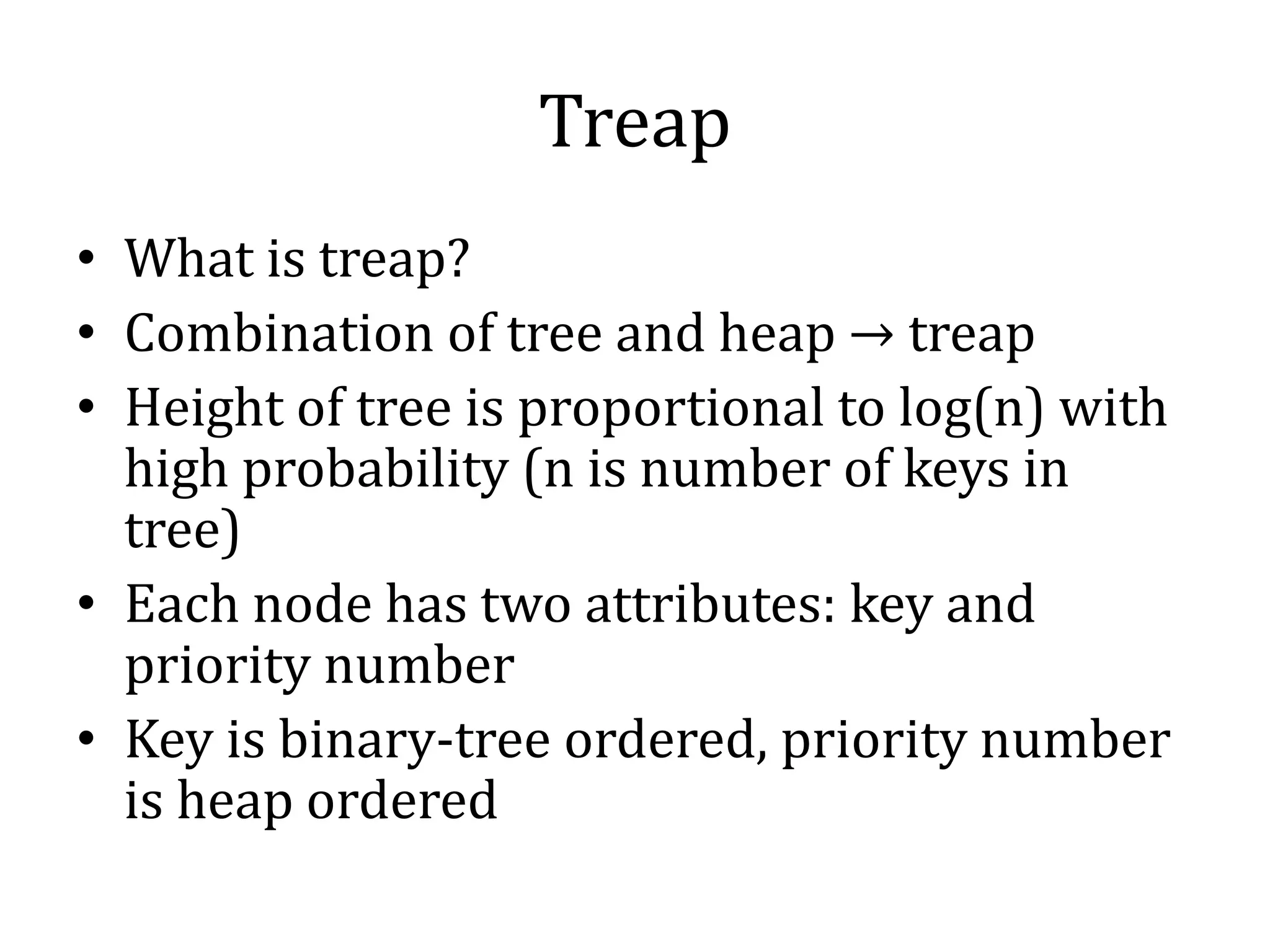
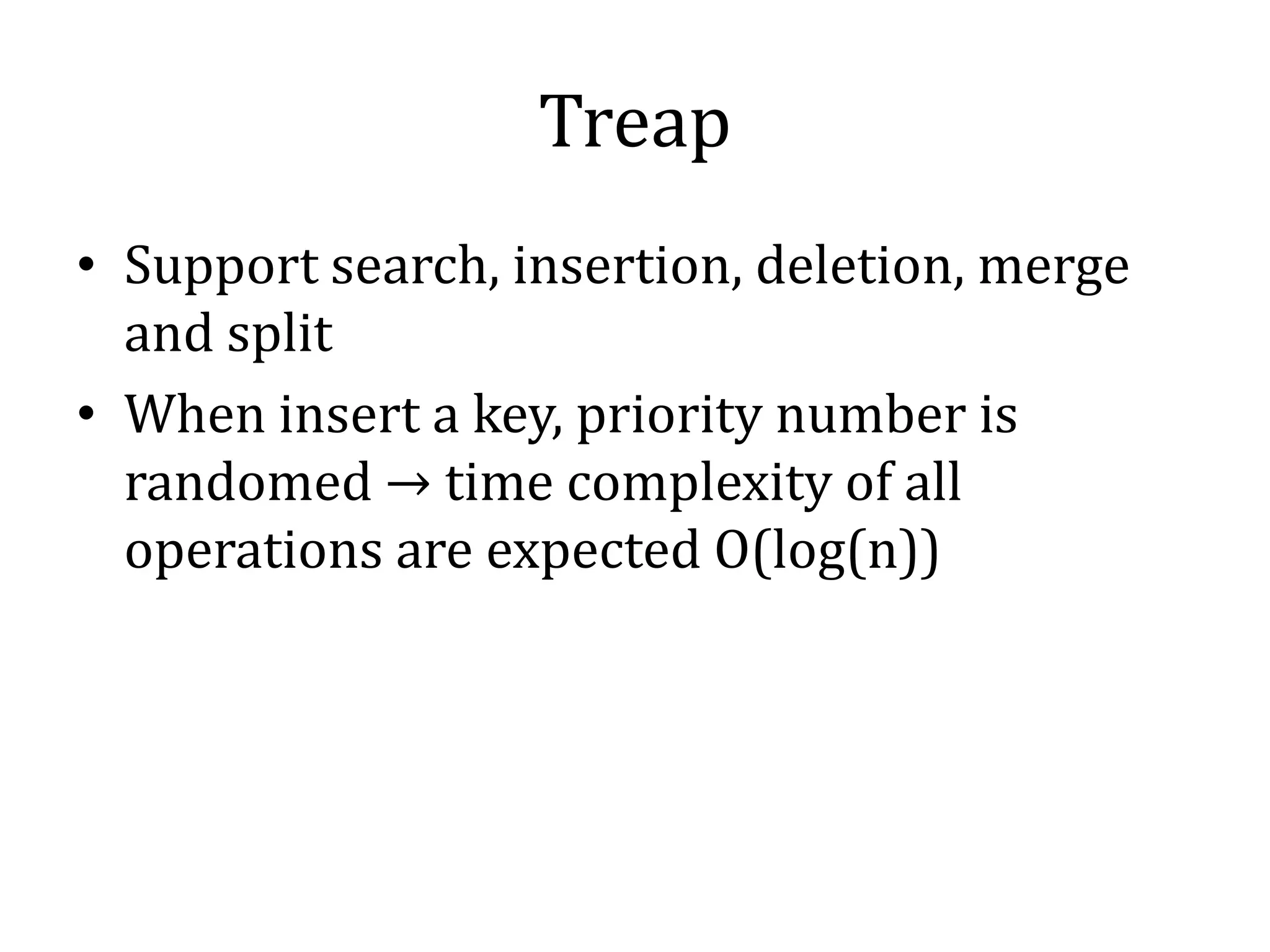
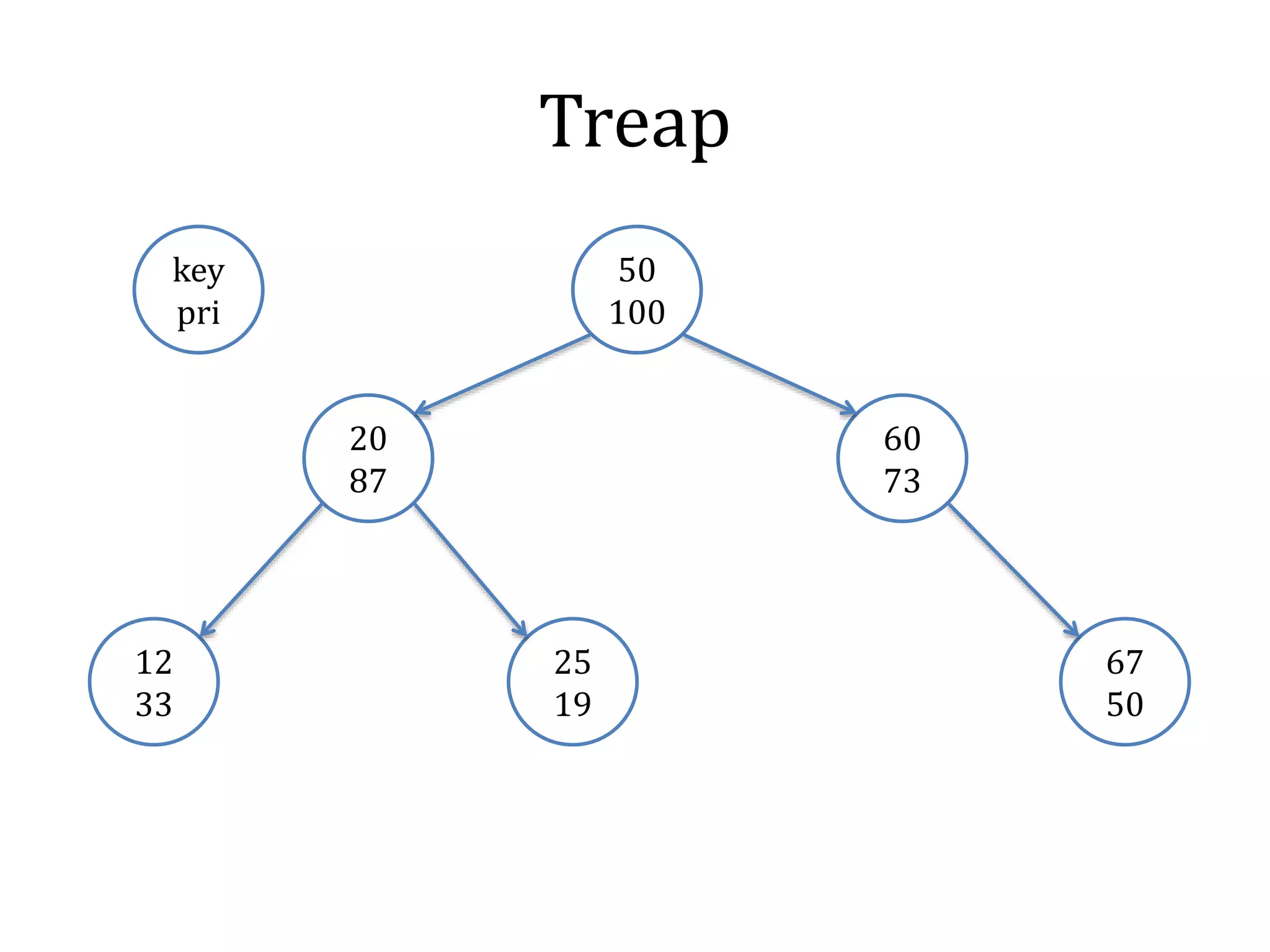
![Treap
typedef struct node {
int val, pri, cnt, sum;
struct node * child[2];
node(int v, int p) : val(v), pri(p), cnt(1), sum(v) {
child[0] = child[1] = NULL;
}
} * node_t;](https://image.slidesharecdn.com/datastructure-tree-141114225212-conversion-gate02/75/Datastructure-tree-46-2048.jpg)
![Treap
int count(node_t t) {
return t ? t->cnt : 0;
}
int sum(node_t t) {
return t ? t->sum : 0;
}
node_t update(node_t t) {
t->cnt = count(t->child[0]) + count(t->child[1]) + 1;
t->sum = sum(t->child[0]) + sum(t->child[1]) + t->val;
return t;
}](https://image.slidesharecdn.com/datastructure-tree-141114225212-conversion-gate02/75/Datastructure-tree-47-2048.jpg)
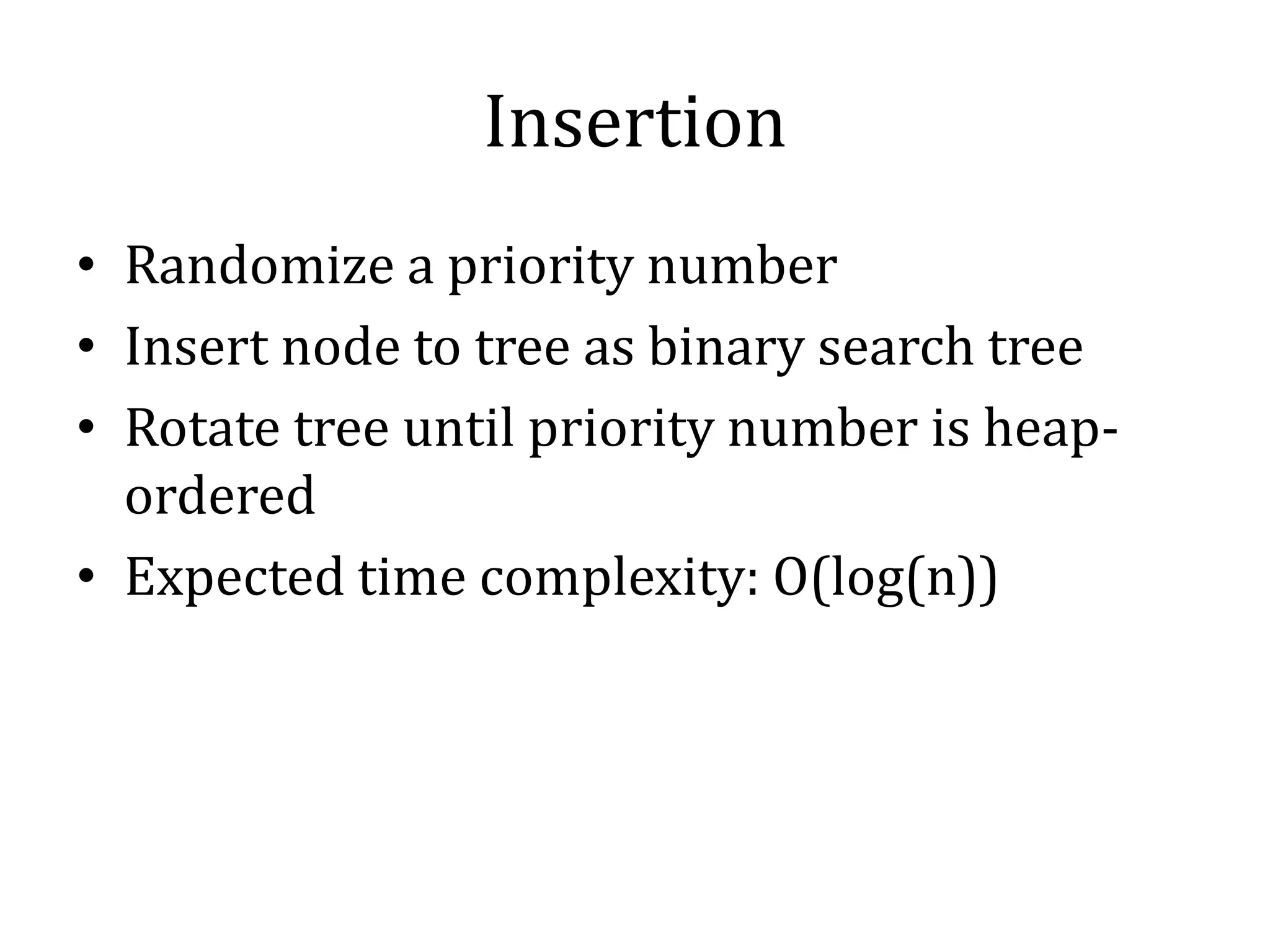
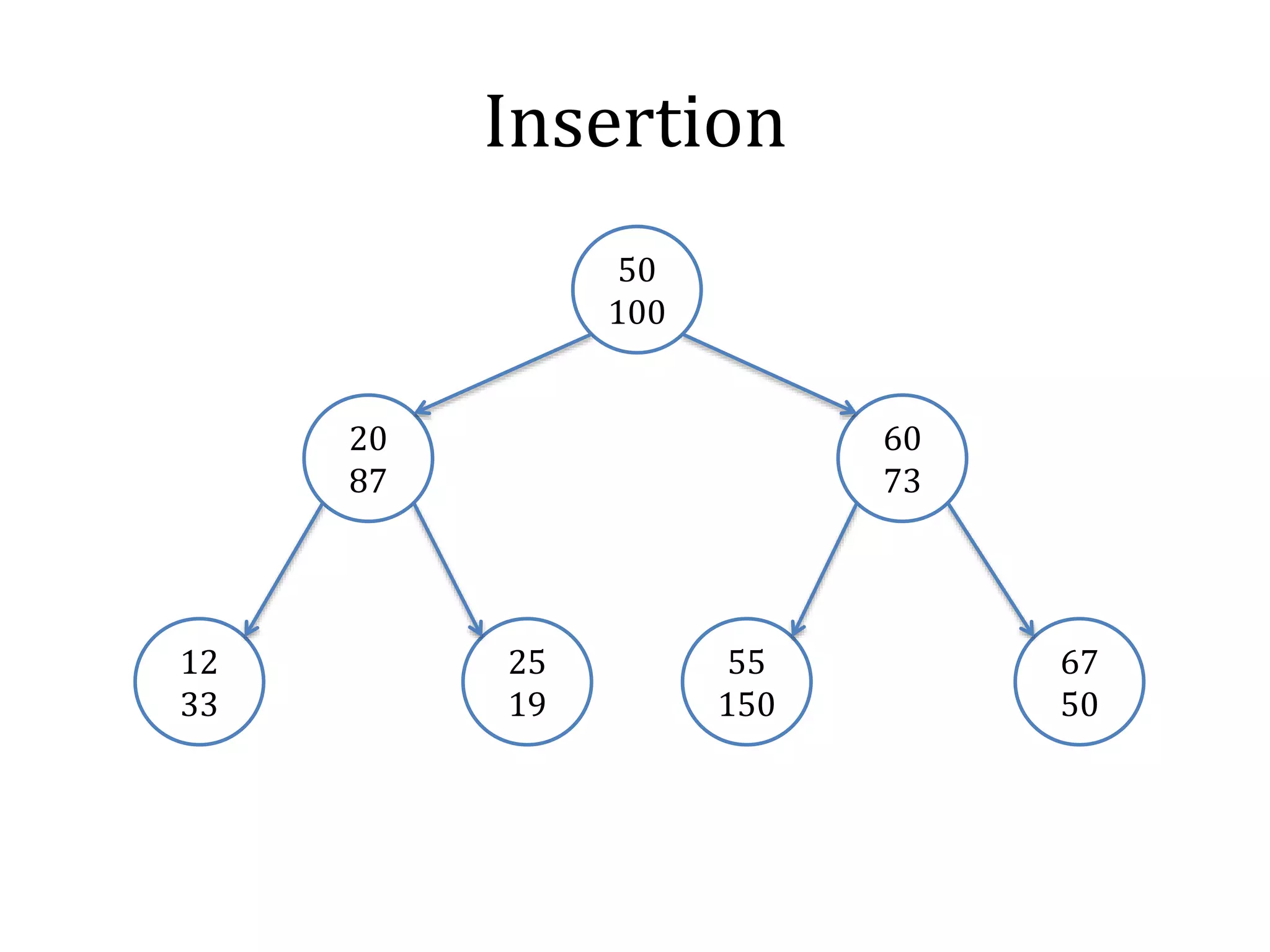
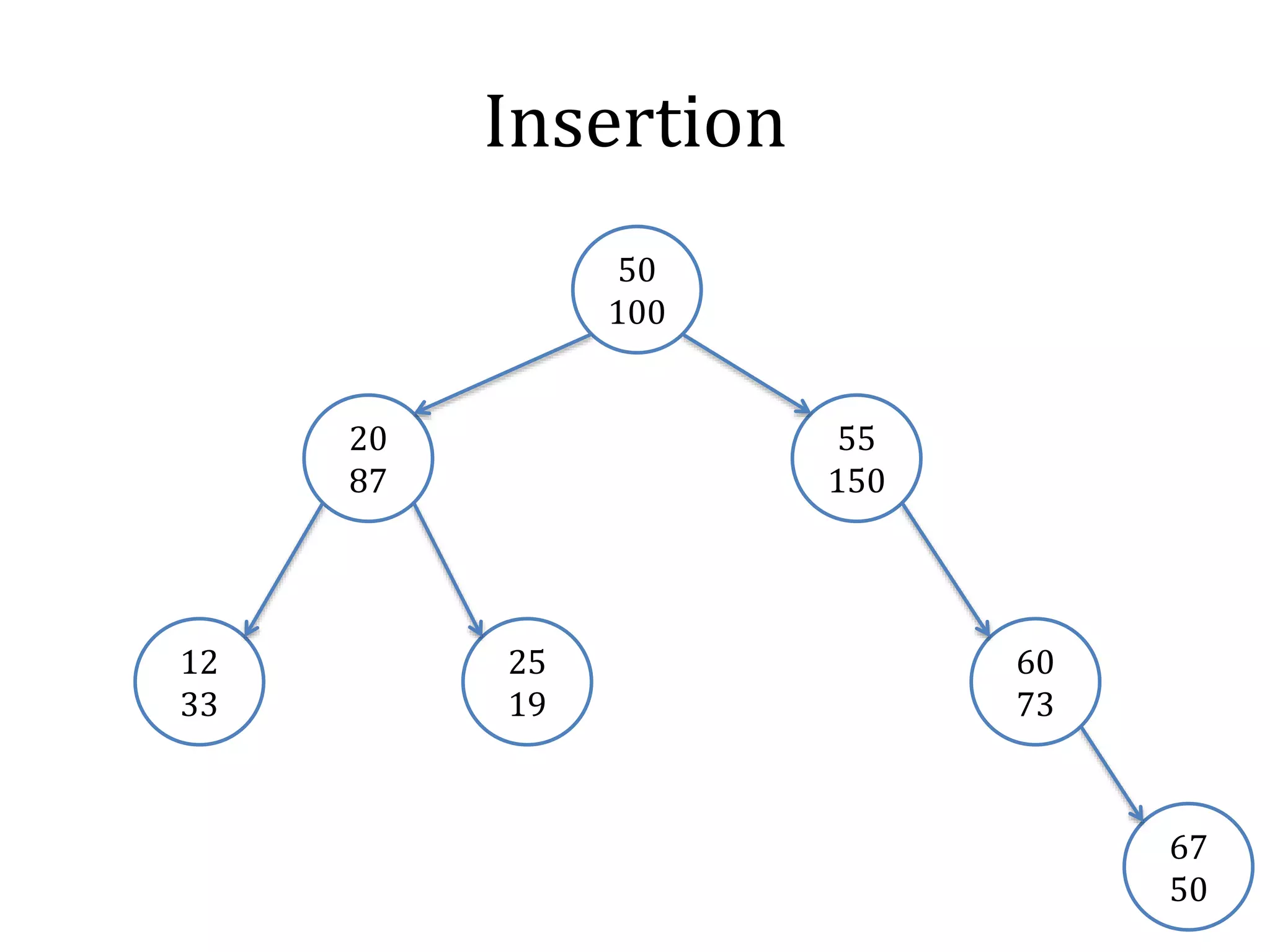
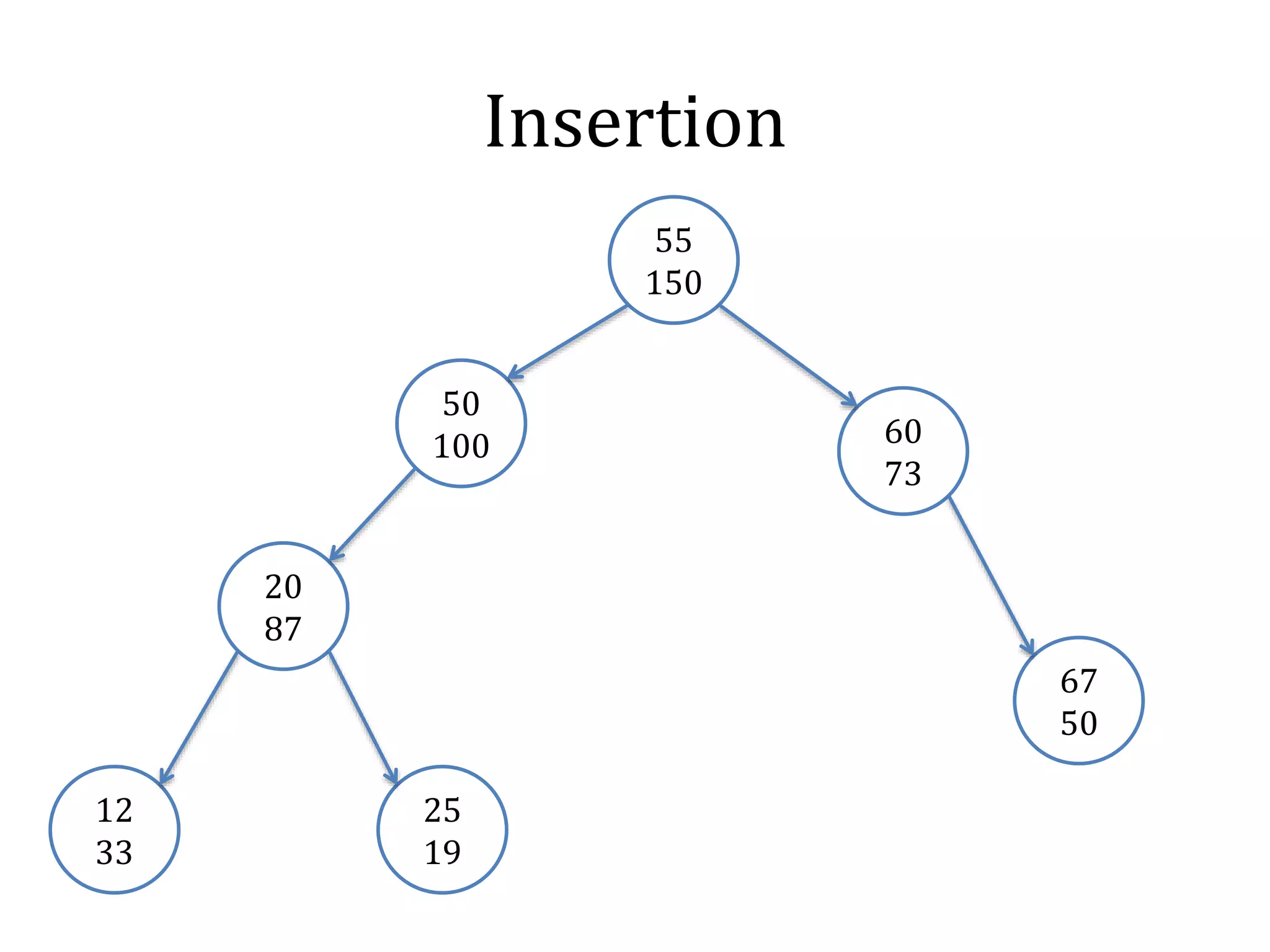
![Rotation
node_t rotate(node_t t, int b) {
node_t s = t->child[b];
t->child[1-b] = s->child[b];
s->child[b] = t;
update(t);
update(s);
return s;
}](https://image.slidesharecdn.com/datastructure-tree-141114225212-conversion-gate02/75/Datastructure-tree-52-2048.jpg)
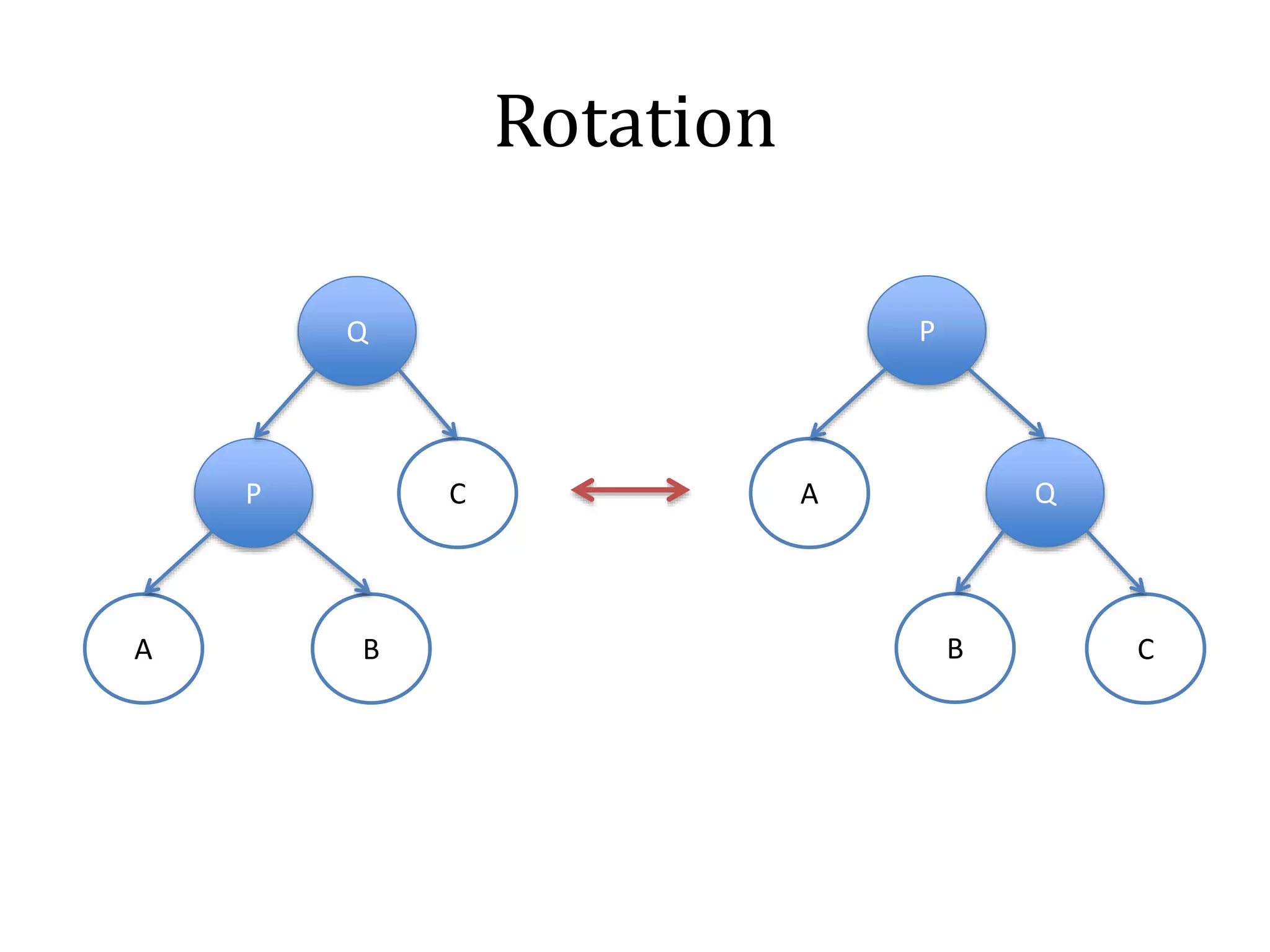
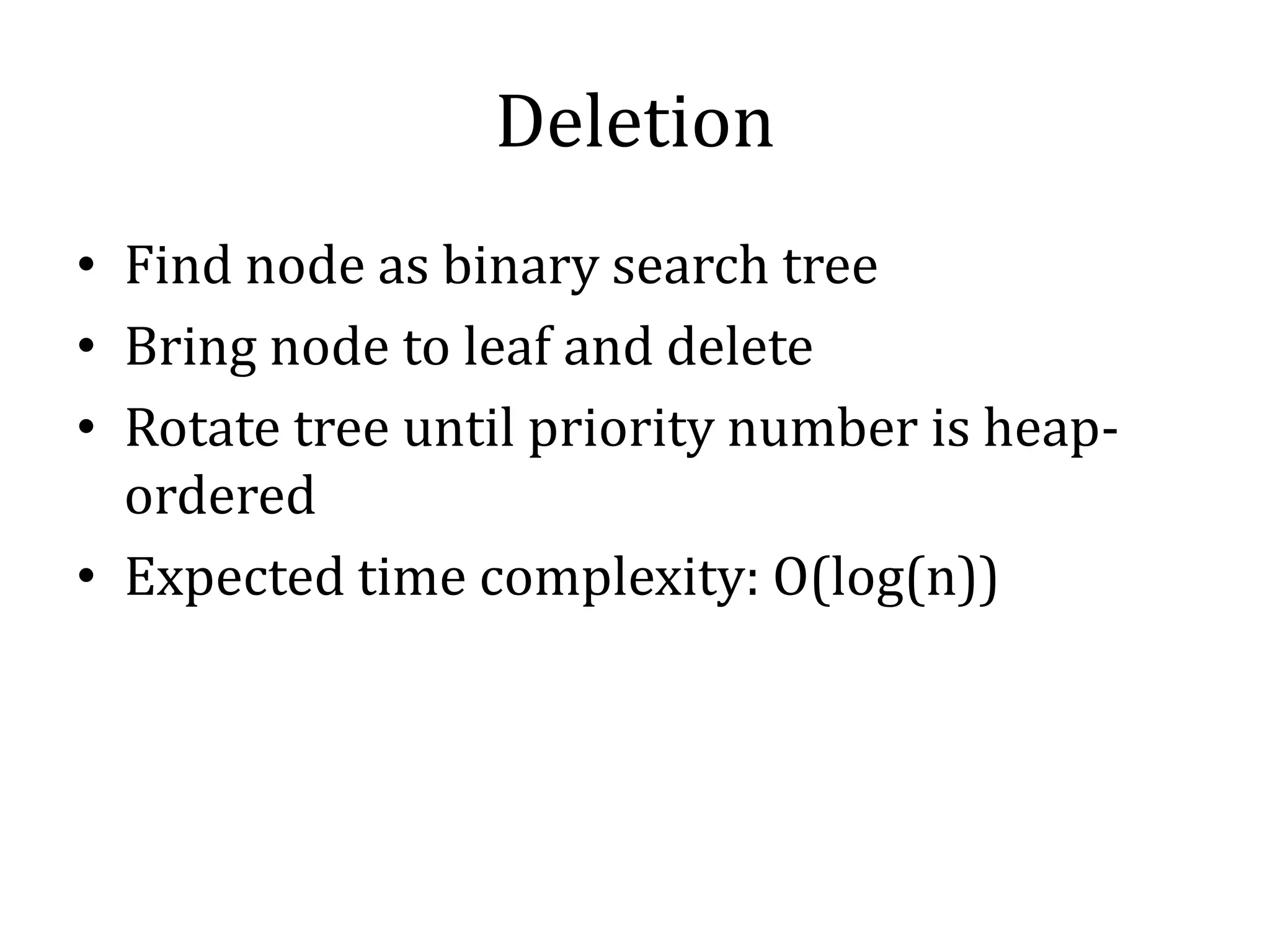
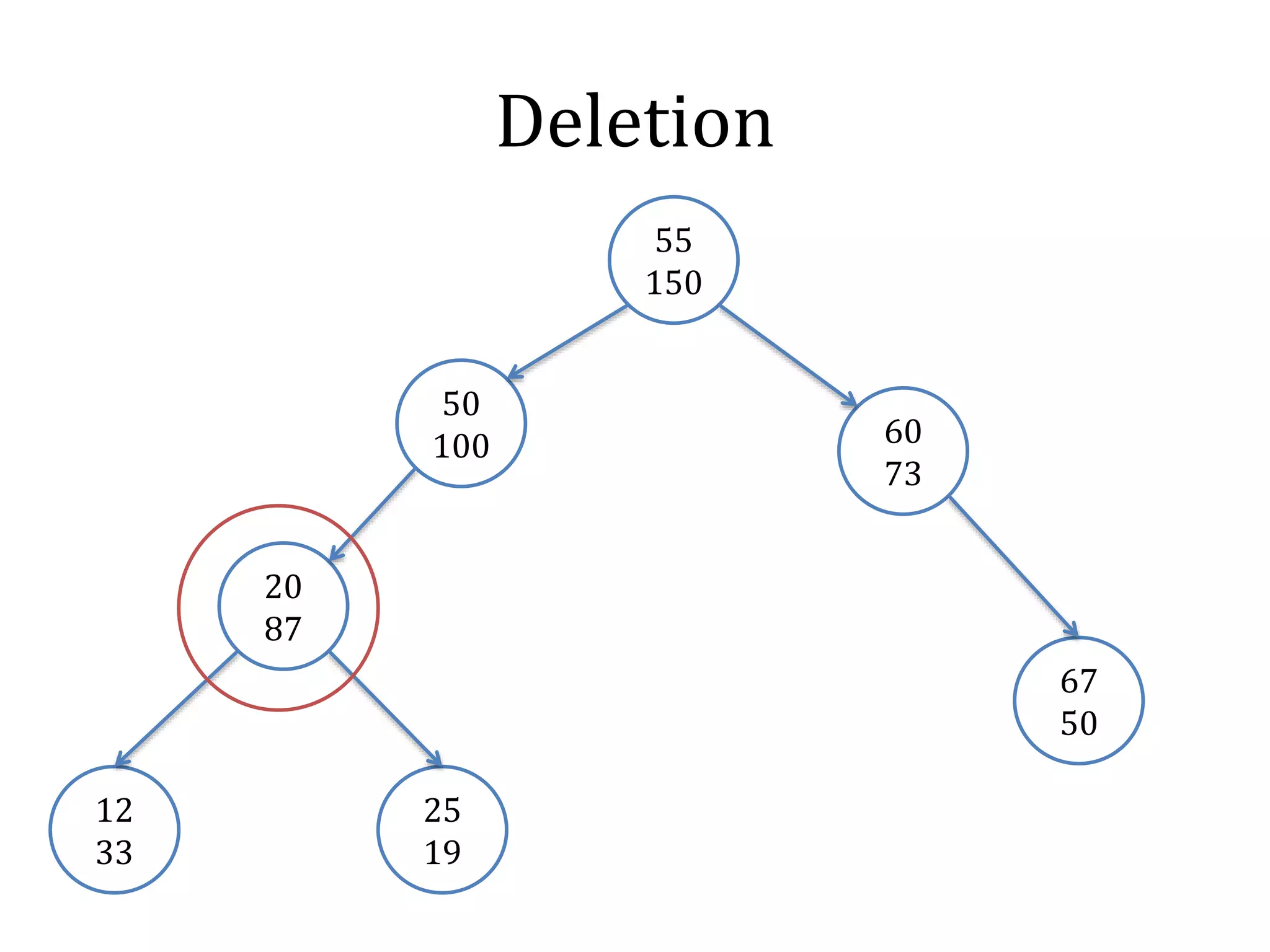
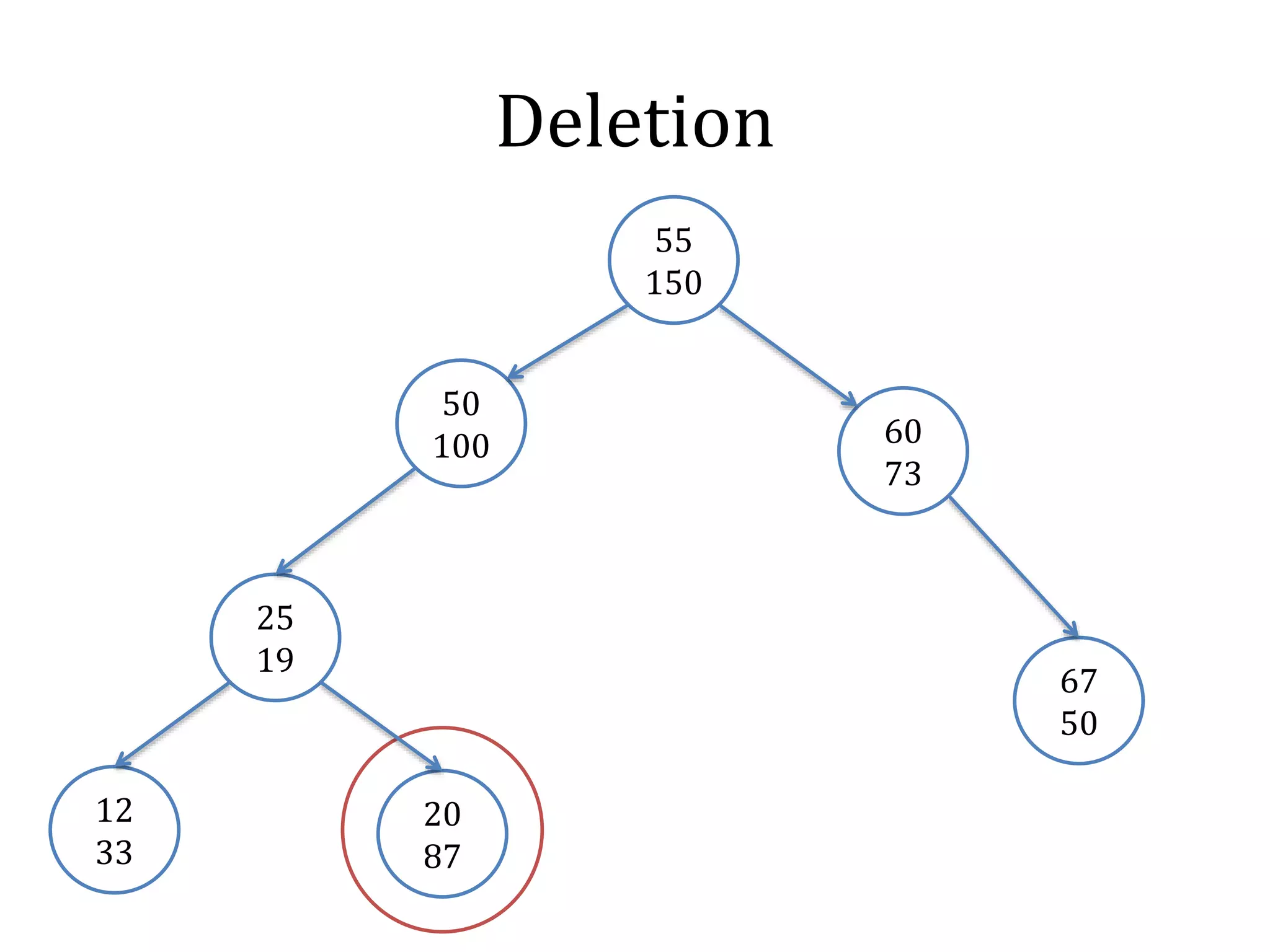
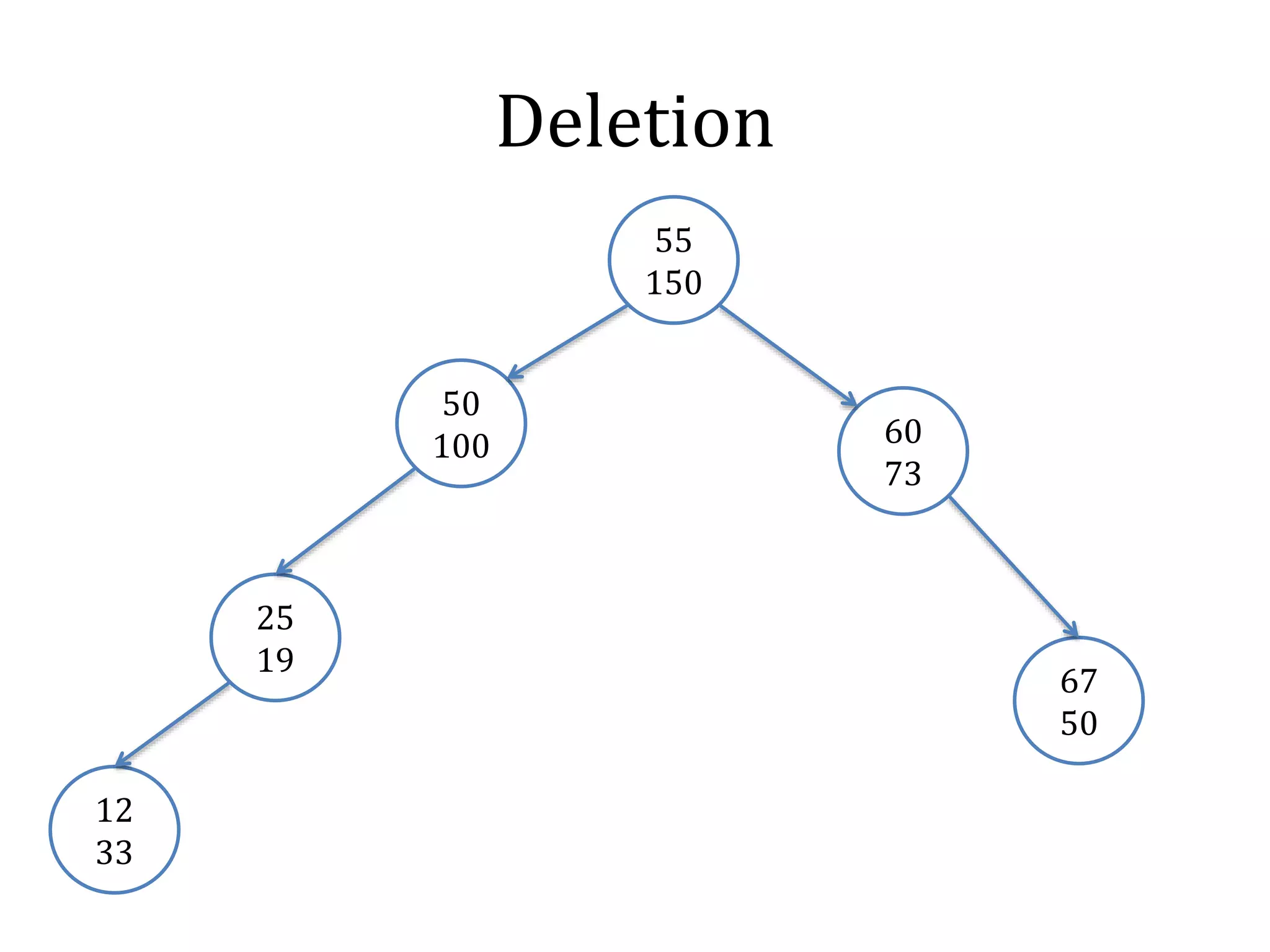
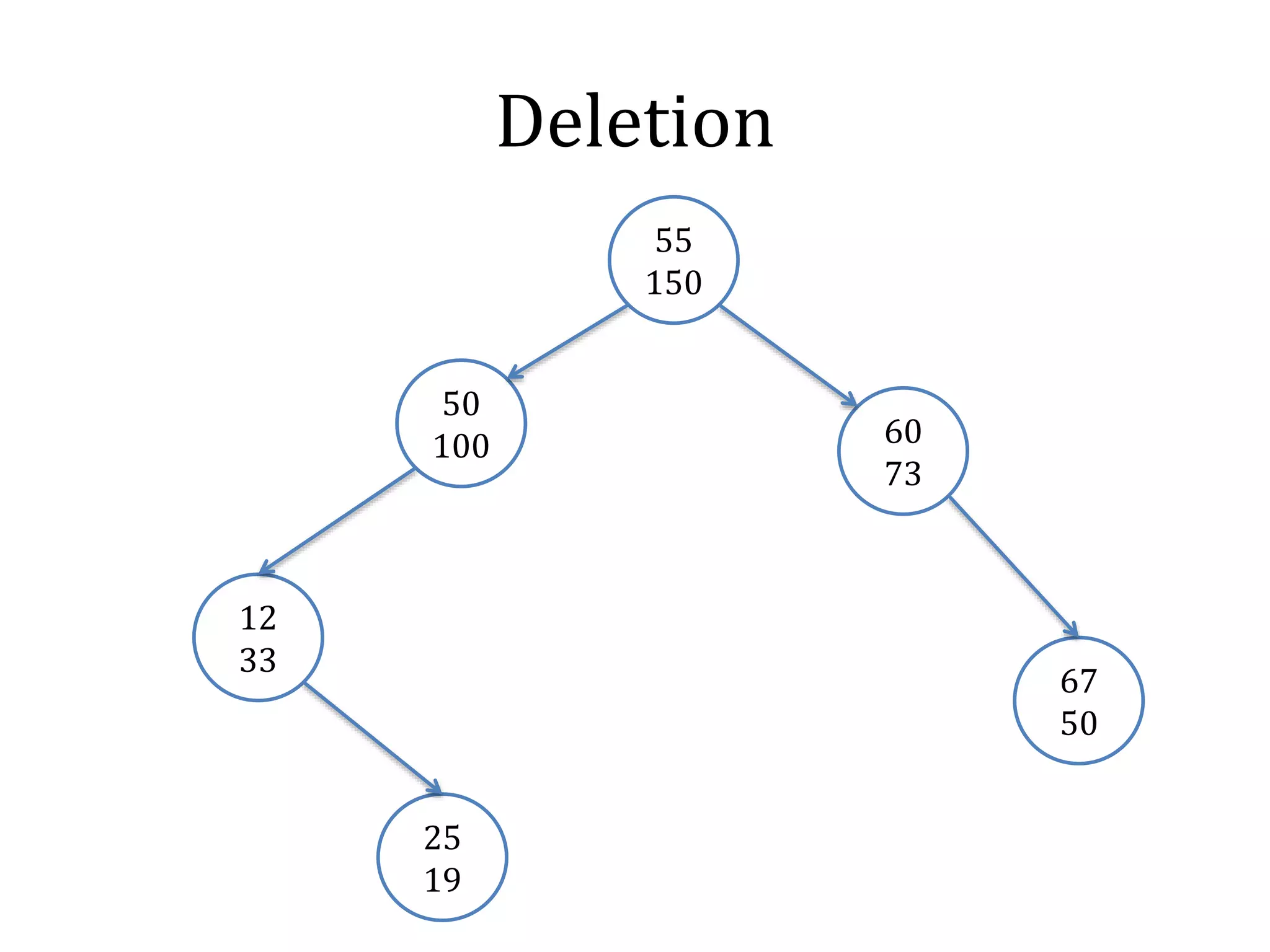
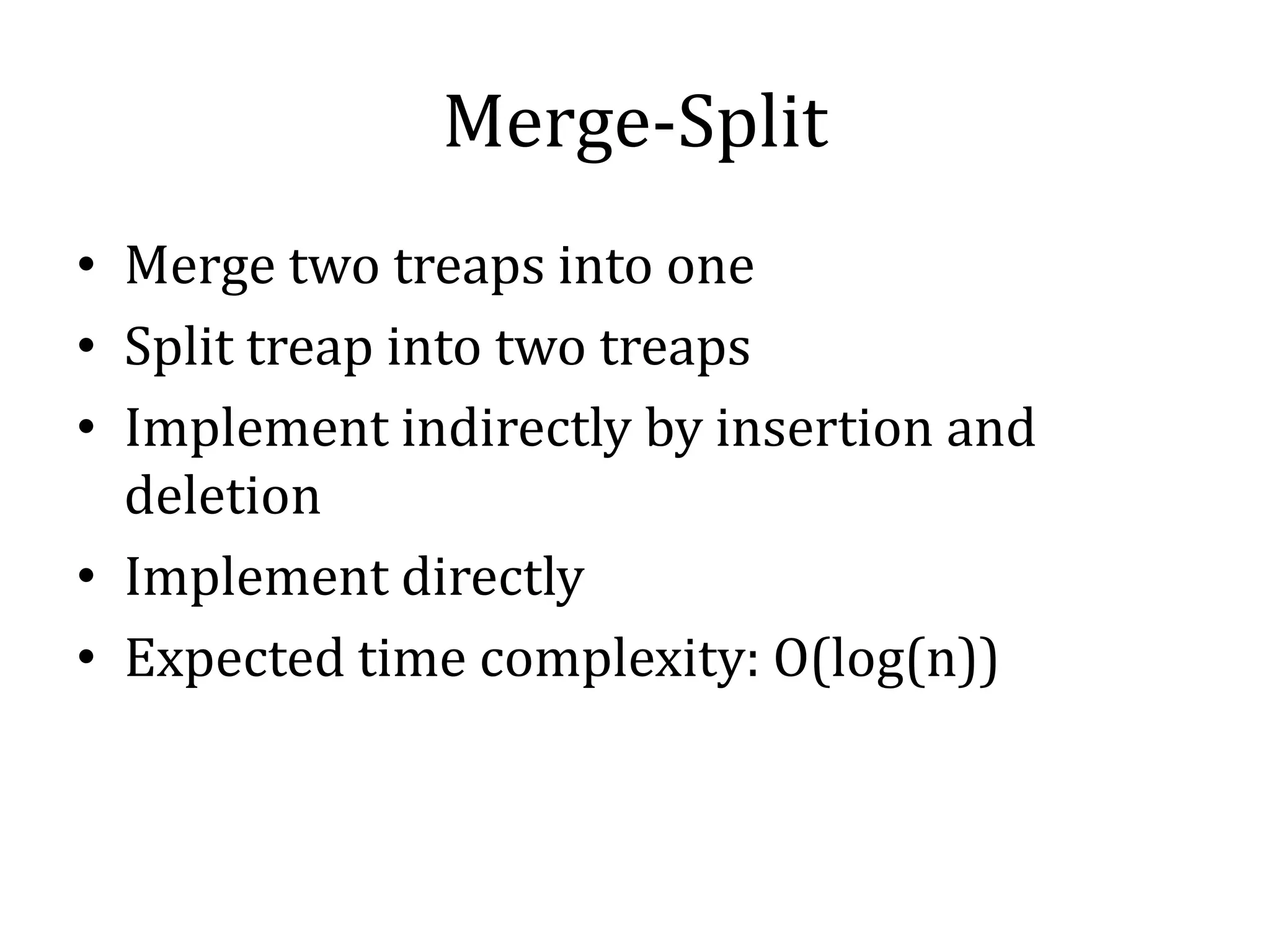
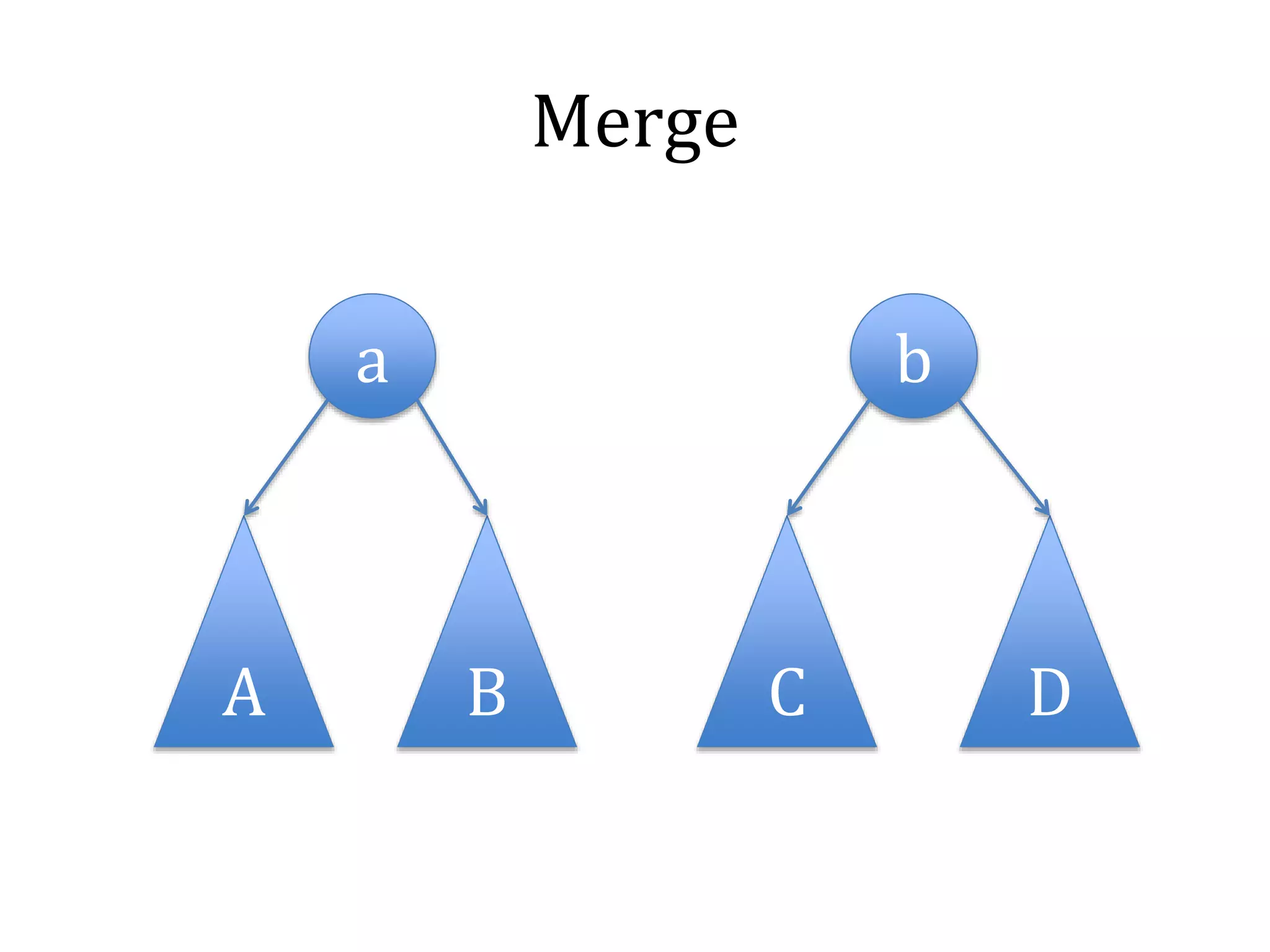
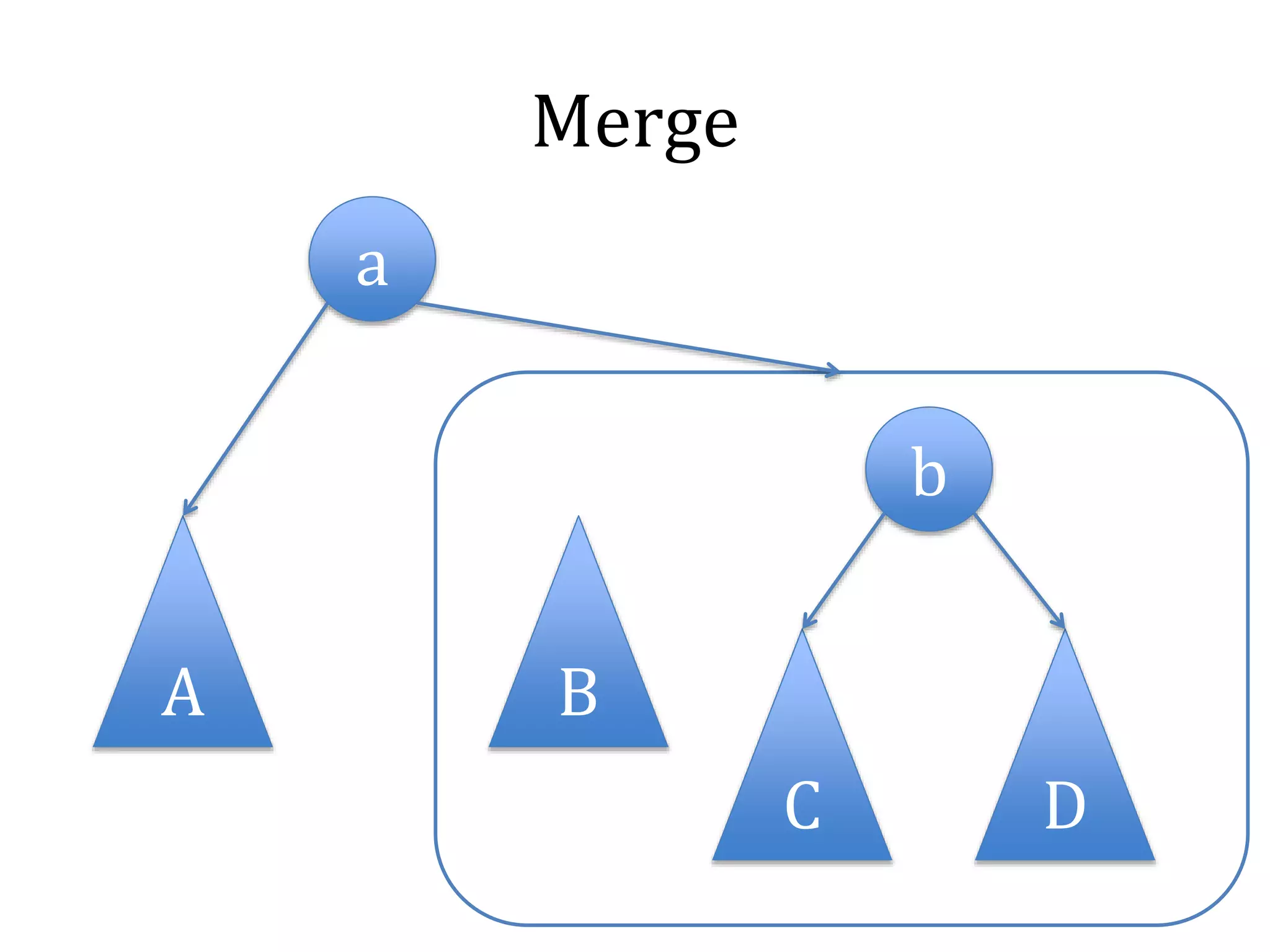
![Merge
node_t merge(node_t l, node_t r) {
if (!l || !r) return !l ? r : l;
if (l->pri > r->pri) {
l->child[1] = merge(l->child[1], r);
return update(l);
}
else {
r->child[0] = merge(l, r->child[0]);
return update(r);
}
}](https://image.slidesharecdn.com/datastructure-tree-141114225212-conversion-gate02/75/Datastructure-tree-62-2048.jpg)
